G. Wayne Miller's Blog, page 11
December 21, 2019
The 2019 Story of the Year. Watch on PBS. Hear on SiriusXM Radio. Listen to the podcast.
Each year since 2013, the Pell Center has announced the public narrative that has made the biggest impact on public affairs in the previous twelve months. This year, “Story in the Public Square” co-hosts Jim Ludes and G. Wayne Miller agree the 2019 Story of the Year is not a single story, but a greater phenomenon: “The fracturing of America’s public narrative.” But there was plenty of competition, and this week’s guest, Brown University professor of sociology and international and public affairs Michael Kennedy, joins us as we break down a momentous year in the U.S. and abroad.
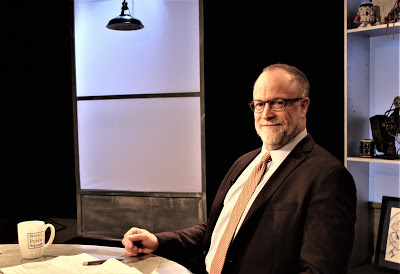 Michael Kennedy. Photo by Erin Barry of the Pell Center at Salve Regina U.
Michael Kennedy. Photo by Erin Barry of the Pell Center at Salve Regina U.
Takeaway One: As different as they may seem, the many popular protests in the U.S. and around the globe in 2019 reflect a universal theme.
And that, Kennedy said, is “a struggle for dignity, and a struggle for community… and also a common struggle against a system that impoverishes and endangers us. The system in which we live may not survive, and it's not because that system will die. It's because the planet can die.”
LISTEN TO THE PODCAST
Takeaway Two: Political right, left or center, climate change is “the connective tissue.” “The environmental catastrophe, the ecological crisis in which we're living, is only going to get worse, so that is the connective tissue,” Kennedy said. “But not everyone sees that. So one of the things that I look at is Trump's supporters. They are profoundly alienated from the system. They look at the ‘deep state.’ They don't look at the deep ecological crisis, but they could because they see their communities being destroyed by environmental dangers. Instead, their attention is redirected elsewhere.”
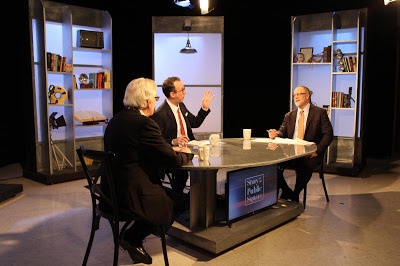
Takeaway Three: American foreign policy is in crisis.“One of the things that I think that we ought to do at the end of 2019 is to take stock of where America is in the world,” Kennedy said. “ We may have improved our position vis-à-vis [Russian president Vladimir] Putin. We may have improved our position vis-à-vis [Turkey’s president Recep Tayyip] Erdogan by pulling out. And, in fact, this debacle of this withdrawal from northeastern Syria abandoning Kurdish allies this is a great gift to Putin and Erdogan because if you're a realist this is the evisceration of American influence in the Middle East.
“If you're a humanitarian, this is a disaster for all of these Kurdish peoples, and all democratically struggling aspiring people in the region. I'm ashamed of this policy in particular, but I'm also so distressed by what Trump has done to American foreign policy in terms of our experts, in terms of our State Department, and our security establishment. You can find so many stories in the press, and even the GOP doesn't want to talk about it because, in fact, they are also embarrassed, but they have to be beholden to the great leader.”
"Story in the Public Square,” a partnership of the Pell Center at Salve Regina University and The Providence Journal, a Gannett newspaper, airs on Rhode Island PBS in Rhode Island and southern Massachusetts on Sundays at 11 a.m. and is rebroadcast Thursdays at 7:30 p.m.; the coast-to-coast broadcast schedule is at http://bit.ly/34fathd An audio version airs 8:30 a.m. and 6:30 p.m. ET, Sundays at 4:30 a.m. and 11:30 p.m., on SiriusXM’s P.O.T.U.S. (Politics of the United States), Channel 124.
Published on December 21, 2019 14:22
December 11, 2019
My Dad and Airplanes
Author's Note: I wrote this seven years ago, on the occasion of the tenth anniversary of my father's death. Like his memory, it has withstood the test of time. I have slightly updated it for today, December 11, 2019, the 17th anniversary of his death. Read the original here.
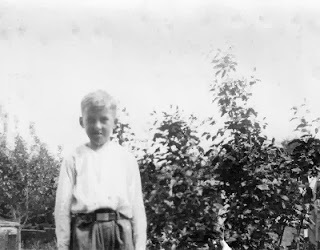 Roger L. Miller as a boy, early 1920s.
Roger L. Miller as a boy, early 1920s.
My Dad and Airplanesby G. Wayne Miller
I live near an airport. Depending on wind direction and other variables, planes sometimes pass directly over my house as they climb into the sky. If I’m outside, I always look up, marveling at the wonder of flight. I’ve witnessed many amazing developments -- the end of the Cold War, the advent of the digital world, for example -- but except perhaps for space travel, which of course is rooted at Kitty Hawk, none can compare.
I also always think of my father, Roger L. Miller, who died 17 years ago today.
Dad was a boy on May 20, 1927, when Charles Lindbergh took off in a single-engine plane from a field near New York City. Thirty-three-and-a-half hours later, he landed in Paris. That boy from a small Massachusetts town who became my father was astounded, like people all over the world. Lindbergh’s pioneering Atlantic crossing inspired him to get into aviation, and he wanted to do big things, maybe captain a plane or even head an airline. But the Great Depression, which forced him from college, diminished that dream. He drove a school bus to pay for trade school, where he became an airplane mechanic, which was his job as a wartime Navy enlisted man and during his entire civilian career. On this modest salary, he and my mother raised a family, sacrificing material things they surely desired.
My father was a smart and gentle man, not prone to harsh judgment, fond of a joke, a lover of newspapers and gardening and birds, chickadees especially. He was robust until a stroke in his 80s sent him to a nursing home, but I never heard him complain during those final, decrepit years. The last time I saw him conscious, he was reading his beloved Boston Globe, his old reading glasses uneven on his nose, from a hospital bed. The morning sun was shining through the window and for a moment, I held the unrealistic hope that he would make it through this latest distress. He died four days later, quietly, I am told. I was not there.
Like others who have lost loved ones, there are conversations I never had with my Dad that I probably should have. But near the end, we did say we loved each other, which was rare (he was, after all, a Yankee). I smoothed his brow and kissed him goodbye.
So on this 17th anniversary, I have no deep regrets. But I do have two impossible wishes.
My first is that Dad could have heard my eulogy, which I began writing that morning by his hospital bed. It spoke of quiet wisdom he imparted to his children, and of the respect and affection family and others held for him. In his modest way, he would have liked to hear it, I bet, for such praise was scarce when he was alive. But that is not how the story goes. We die and leave only memories, a strictly one-way experience.
My second wish would be to tell Dad how his only son has fared in the last 17 years. I know he would have empathy for some bad times I went through and be proud that I made it. He would be happy that I found a woman I love, Yolanda, my wife now for four years and my best friend for more than a decade: someone, like him, who loves gardening and birds. He would be pleased that my three wonderful children, Rachel, Katy and Cal, are making their way in the world; and that he now has three great-granddaughters, Bella, Livvie and Viv, wonderful girls all. In his humble way, he would be honored to know how frequently I, my sister Mary Lynne and my children remember and miss him. He would be saddened to learn that my other sister, his younger daughter, Lynda, died in 2015. But that is not how the story goes, either. We send thoughts to the dead, but the experience is one-way. We treasure photographs, but they do not speak.
Lately, I have been poring through boxes of black-and-white prints handed down from Dad’s side of my family. I am lucky to have them, more so that they were taken in the pre-digital age -- for I can touch them, as the people captured in them surely themselves did so long ago. I can imagine what they might say, if in fact they could speak.
Some of the scenes are unfamiliar to me: sailboats on a bay, a stream in winter, a couple posing on a hill, the woman dressed in fur-trimmed coat. But I recognize the house, which my grandfather, for whom I am named, built with his farmer’s hands; the coal stove that still heated the kitchen when I visited as a child; the birdhouses and flower gardens, which my sweet grandmother lovingly tended. I recognize my father, my uncle and my aunts, just children then in the 1920s. I peer at Dad in these portraits (he seems always to be smiling!), and the resemblance to photos of me at that age is startling, though I suppose it should not be.
A plane will fly over my house today, I am certain. When it does, I will go outside and think of young Dad, amazed that someone had taken the controls of an airplane in America and stepped out in France. A boy with a smile, his life all ahead of him.
 My dad, second from top, with two of his sisters and his brother.
My dad, second from top, with two of his sisters and his brother.
 Roger L. Miller as a boy, early 1920s.
Roger L. Miller as a boy, early 1920s.
My Dad and Airplanesby G. Wayne Miller
I live near an airport. Depending on wind direction and other variables, planes sometimes pass directly over my house as they climb into the sky. If I’m outside, I always look up, marveling at the wonder of flight. I’ve witnessed many amazing developments -- the end of the Cold War, the advent of the digital world, for example -- but except perhaps for space travel, which of course is rooted at Kitty Hawk, none can compare.
I also always think of my father, Roger L. Miller, who died 17 years ago today.
Dad was a boy on May 20, 1927, when Charles Lindbergh took off in a single-engine plane from a field near New York City. Thirty-three-and-a-half hours later, he landed in Paris. That boy from a small Massachusetts town who became my father was astounded, like people all over the world. Lindbergh’s pioneering Atlantic crossing inspired him to get into aviation, and he wanted to do big things, maybe captain a plane or even head an airline. But the Great Depression, which forced him from college, diminished that dream. He drove a school bus to pay for trade school, where he became an airplane mechanic, which was his job as a wartime Navy enlisted man and during his entire civilian career. On this modest salary, he and my mother raised a family, sacrificing material things they surely desired.
My father was a smart and gentle man, not prone to harsh judgment, fond of a joke, a lover of newspapers and gardening and birds, chickadees especially. He was robust until a stroke in his 80s sent him to a nursing home, but I never heard him complain during those final, decrepit years. The last time I saw him conscious, he was reading his beloved Boston Globe, his old reading glasses uneven on his nose, from a hospital bed. The morning sun was shining through the window and for a moment, I held the unrealistic hope that he would make it through this latest distress. He died four days later, quietly, I am told. I was not there.
Like others who have lost loved ones, there are conversations I never had with my Dad that I probably should have. But near the end, we did say we loved each other, which was rare (he was, after all, a Yankee). I smoothed his brow and kissed him goodbye.
So on this 17th anniversary, I have no deep regrets. But I do have two impossible wishes.
My first is that Dad could have heard my eulogy, which I began writing that morning by his hospital bed. It spoke of quiet wisdom he imparted to his children, and of the respect and affection family and others held for him. In his modest way, he would have liked to hear it, I bet, for such praise was scarce when he was alive. But that is not how the story goes. We die and leave only memories, a strictly one-way experience.
My second wish would be to tell Dad how his only son has fared in the last 17 years. I know he would have empathy for some bad times I went through and be proud that I made it. He would be happy that I found a woman I love, Yolanda, my wife now for four years and my best friend for more than a decade: someone, like him, who loves gardening and birds. He would be pleased that my three wonderful children, Rachel, Katy and Cal, are making their way in the world; and that he now has three great-granddaughters, Bella, Livvie and Viv, wonderful girls all. In his humble way, he would be honored to know how frequently I, my sister Mary Lynne and my children remember and miss him. He would be saddened to learn that my other sister, his younger daughter, Lynda, died in 2015. But that is not how the story goes, either. We send thoughts to the dead, but the experience is one-way. We treasure photographs, but they do not speak.
Lately, I have been poring through boxes of black-and-white prints handed down from Dad’s side of my family. I am lucky to have them, more so that they were taken in the pre-digital age -- for I can touch them, as the people captured in them surely themselves did so long ago. I can imagine what they might say, if in fact they could speak.
Some of the scenes are unfamiliar to me: sailboats on a bay, a stream in winter, a couple posing on a hill, the woman dressed in fur-trimmed coat. But I recognize the house, which my grandfather, for whom I am named, built with his farmer’s hands; the coal stove that still heated the kitchen when I visited as a child; the birdhouses and flower gardens, which my sweet grandmother lovingly tended. I recognize my father, my uncle and my aunts, just children then in the 1920s. I peer at Dad in these portraits (he seems always to be smiling!), and the resemblance to photos of me at that age is startling, though I suppose it should not be.
A plane will fly over my house today, I am certain. When it does, I will go outside and think of young Dad, amazed that someone had taken the controls of an airplane in America and stepped out in France. A boy with a smile, his life all ahead of him.
 My dad, second from top, with two of his sisters and his brother.
My dad, second from top, with two of his sisters and his brother.
Published on December 11, 2019 03:09
November 7, 2019
My opening remarks at the New England First Amendment Coalition’s “First Amendment and the Free Press”
November 6, 2019, at the Providence Community Library’s Olneyville branch. I moderated a panel of four speakers (including me!).
Thank you, Joseph, and welcome everyone to the New England First Amendment Coalition’s continuing community conversation. Thanks to the Providence Community Library’s Olneyville branch for hosting us. At a moment when many governments at the local, state and national levels are emboldened to restrict or deny access to what should be public records – when politicians in Washington and elsewhere spew nonsense about so-called “fake news: and call journalist “enemies of the people” – when the bedrock principle of truth is derided by some – no topic could be more timely and important than the “First Amendment and the Free Press.”Before we begin, I thought it appropriate to read the First Amendment, which Congress adopted as one of the ten provisions of The Bill of Rights: “Congress shall make no law respecting an establishment of religion, or prohibiting the free exercise thereof; or abridging the freedom of speech, or of the press; or the right of the people peaceably to assemble, and to petition the Government for a redress of grievances.”I think we can all agree that this one incredible sentence – as relevant today as 230 years ago, when James Madison wrote it -- is a cornerstone of American democracy. And yet, it seems increasingly under attack.
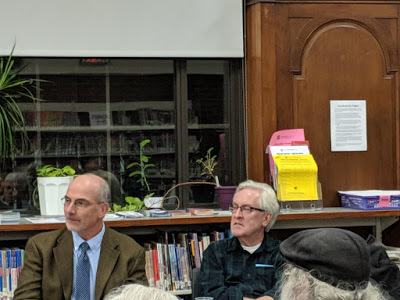
So I think we can expect a lively discussion tonight built around questions from the audience. Now. let me introduce my fellow panelists.Tom Mooney has covered many of the biggest stories in Rhode Island for more than 30 years for The Providence Journal: from calamities, crime, courts and corruption to slice of life features and special projects. He's investigated failings within the DCYF and the money and players behind the booming marijuana business. Earlier this year he wrote a series of stories about agencies that routinely deny access to public records and violate the open meetings law. For 14 years he's also taught journalism at Brown University.
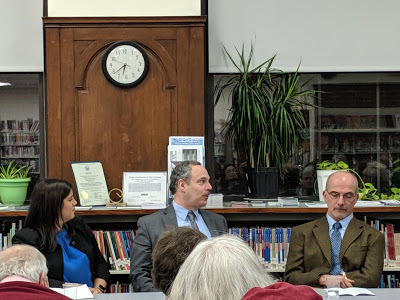 L to R: Steph Machado, Steve Brown, Tom Mooney.Steph Machado is a Target 12 investigative reporter for WPRI 12, holding government officials accountable at Providence City Hall and the Rhode Island State House. She has worked at WPRI TV, Channel 12, since 2015, and was previously a State House reporter in Vermont. A graduate of the Newhouse School at Syracuse University, Steph on her web site notes that she specializes in digital journalism, too, and is “a storyteller at heart.”Steven Brown is executive director of the American Civil Liberties Union of Rhode Island, and has served in that capacity for over thirty years. During that time, the state ACLU has filed over 600 lawsuits covering a broad range of civil liberties and constitutional issues, including dozens of cases vindicating the public's rights under the First Amendment and the Access to Public Records Act. Before coming to Rhode Island, he was executive director of the Iowa Civil Liberties Union and he worked at the Philadelphia ACLU.Steve, maybe you can get us started with your overall assessment of access to public records that residents of Rhode Island have – or don’t – at the end of 2019.
L to R: Steph Machado, Steve Brown, Tom Mooney.Steph Machado is a Target 12 investigative reporter for WPRI 12, holding government officials accountable at Providence City Hall and the Rhode Island State House. She has worked at WPRI TV, Channel 12, since 2015, and was previously a State House reporter in Vermont. A graduate of the Newhouse School at Syracuse University, Steph on her web site notes that she specializes in digital journalism, too, and is “a storyteller at heart.”Steven Brown is executive director of the American Civil Liberties Union of Rhode Island, and has served in that capacity for over thirty years. During that time, the state ACLU has filed over 600 lawsuits covering a broad range of civil liberties and constitutional issues, including dozens of cases vindicating the public's rights under the First Amendment and the Access to Public Records Act. Before coming to Rhode Island, he was executive director of the Iowa Civil Liberties Union and he worked at the Philadelphia ACLU.Steve, maybe you can get us started with your overall assessment of access to public records that residents of Rhode Island have – or don’t – at the end of 2019.
Published on November 07, 2019 11:33
October 6, 2019
Toy Wars: Lucky Pennies (the chapter that draws you into the story)
Excerpt from the best-selling and critically acclaimed "Toys Wars: The Epic Struggle Between G.I. Joe, Barbie, and the Companies That Make Them," originally published in 1998, and republished in 2019 as a companion to the sequel, "Kid Number One: A Story of Heart, Soul and Business, featuring Alan Hassenfeld and Hasbro."The new edition of "Toy Wars" is available as a paperback and a Kindle e-book. Copyright 1998 G. Wayne Miller, renewed 2019.
The "Toy Wars" Table of Contents is at the end of this excerpt. For rare and never-before-seen images, video, audio and more, visit the "Toy Wars" Facebook page. And follow "Toy Wars" on Twitter: @toywarstv
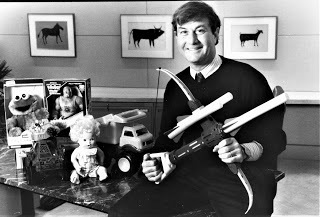
``Good morning,'' he began, his voice slightly tremulous, but only to someone listening for it. ``Today we are here to review our 1995 performance and share with you Hasbro's outlook for 1996 and beyond. For that reason, I will not be talking about the now-ended Mattel proposal.''Looking to the last row, Hassenfeld saw Mattel's two leaders. Chairman and CEO John W. Amerman was a slender man of average height whose white hair, baritone voice and expensive tailoring projected an image of someone considerably larger; at sixty-four, his passions were golf, German shepherds, and thoroughbred horses. Sitting to his left was Jill E. Barad, forty-four, who had risen to chief operating officer and president largely on her success with Barbie, a doll that promised glamorous fantasy to little girls and handsome bonuses to executives. Worldwide sales of Barbie last year had reached an extraordinary $1.4 billion, a feat no other toy of any kind had ever accomplished. Amerman and Barad were unusually attentive, for today was the first time this year Hassenfeld had faced the industry's powers. Mattel insiders pictured themselves as sharks, and the agony they'd caused Hasbro over the last month -- the battering punishment that had pushed Hassenfeld and his inner circle to exhaustion, if not the verge of breakdown -- had more than confirmed that reputation. Even if Alan didn't discuss Mattel's spurned offer, Amerman and Barad might learn more clues about the damage they'd inflicted. No telling when they might be tempted to strike again.Even before launching its stunning takeover attempt, with a fax to Hassenfeld the morning of January 16, precisely two hours after he'd returned from winter vacation, Mattel had become the new darling of the toy industry. Its flagship brands -- Barbie, Fisher-Price, Hot Wheels, and Disney -- were all vigorous, helping the company to end 1995 with its seventh consecutive year of record sales and earnings. No toy company had ever made $358 million, but one had come close. Only two years ago, at this same conference, Hassenfeld had reported the largest revenues and earnings in Hasbro's history. Without gloating, which was not his style, he'd reminded Wall Street that a thousand shares of Hasbro stock purchased for less than $15,000 in 1982 would have been worth almost a million dollars twelve years later. He'd joked about his mother's approval of such arithmetic and shown a slide of his greatest philanthropic achievement: a newly opened children's hospital, in his hometown, that bore his company's name. Two years ago, Mattel had been in second place, a position that vexed its corporate soul.
•
Unlike his older brother, Stephen, a masterful orator who'd preceded him as chairman and CEO, Alan did not relish public speaking, even to friendly audiences. Financial presentations were his nemesis.Ordinarily, he relied on humor to get underway, but his advisers had persuaded him this was no time for frivolity. Nor had it been considered wise to begin with one of Hasbro's brilliant television commercials, as he customarily did to lighten the atmosphere at what otherwise was a half day or more of undiluted dreariness. And he would not close with his usual remarks about Hasbro's commitment to social responsibility, which was at the core of his corporate and personal beliefs. Wall Street had wearied of Hassenfeld's causes. Especially in light of the Mattel offer, Wall Street was interested only in earnings and the price of stock -- and how the chairman intended to multiply both. Wearing a purple button with the letters ESV, for Enhance Shareholder Value, would not suffice. Hassenfeld had to get directly into the numbers -- the area of the business where, he was first to admit, he was least expert.He began with the fourth quarter of 1995, the first billion-dollar quarter in Hasbro history, and moved on to the full-year results. Hasbro's revenues had risen modestly and earnings, while down, were nothing to be ashamed of: $155 million, or $1.76 a share. Many a private businessman would have uncorked champagne over such numbers, but Wall Street judged Hasbro (like Mattel) by the merciless measure of growth. It was an expectation established by Stephen, and one price to be paid for continuing membership in the Fortune 500.``While our 1995 full-year results were essentially flat,'' Alan said, ``we have momentum coming into the new year.'' The games and international divisions, he reported, had had impressive years. Batman and Star Wars toys remained hot and retail sales on many other lines were encouragingly strong. Mr. Potato Head, Hasbro's first hit more than forty years ago, was the surprise star of Toy Story, the Christmas season's box-office smash. All had contributed to Hasbro's continuing strong balance sheet.And it was there, in the middle of cash flow and debt, that Hassenfeld's heart started to race and the Grand Ballroom began to go black.Almost seven years into his chairmanship, Hassenfeld still sometimes felt like an impostor. It was a feeling of wicked wonder, like the Tom Hanks character in the movie Big, a boy who one day wakes up an adult in the eyes of the world -- an adult who just so happens to be a major toy-company executive responsible for, and in love with, design and development of toys. Unpleasurable moments at financial forums were the price to be paid for being Kid Number One, as Hassenfeld sometimes called himself, but this was different than any discomfort he'd experienced before. Lucky pennies and all, Hassenfeld was about to faint.He reached for a glass of water, praying it would sustain him.
•
He did not faint; his twelve-second pause seemed eternal to him, but went unremarked upon by most everyone else. He drank his water, found his confidence and continued on with his presentation, rich with references to global brand-building, the key to Mattel's success and, he now believed, his own company's future. Financials dispensed with, he rolled a dozen of Hasbro's finest new commercials, outlined some of the steps he would take to improve his company's performance, and hinted at even greater changes to come. Hassenfeld closed with a kind of prediction he'd never made: a specific dollar amount ($65 million) for increased profit in the year ahead, offered as a token of his newfound resolve to enrich his stockholders. General applause and a private handshake from Amerman followed. The ugly questions his advisers had prepared him for -- ``Alan, if you can't enhance shareholder value, will you step down?'' ``Alan, how bad is the blood between you and John Amerman?'' -- failed to materialize. ``It's done, baby! Behind you!'' Wayne S. Charness, Hasbro's vice president of corporate communications, said as their chauffeur-driven Lincoln Town Car traveled south on Fifth Avenue toward Hasbro's showroom, crowded with buyers this third day of American International Toy Fair, the worldwide industry's largest show. Hassenfeld was in front, legs tucked into his chest, breathing in a Parliament cigarette, oblivious to anything but the remembrance of his presentation. Charness adjusted the seat to give his boss more room.``With the adrenaline pumping the way it was at the beginning, I was almost over-ready,'' Hassenfeld said. ``I think that's why I went blind for a minute.''``It was beautiful,'' Charness said.``You wouldn't say anything different.''``I tell you when you stink.'' Charness assured him that no one in the audience knew what had happened in those twelve dark seconds.``I was really, really scared,'' Hassenfeld said.``It's over,'' Charness said, but his reference was only to this morning. For new pressures awaited Hassenfeld as he neared the Hasbro showroom, on West Twenty-third Street. His board would meet the next day and directors were ornery. They'd been put on the defensive for rejecting Mattel's offer -- Fifty-three dollars a share, they kept hearing, are you crazy? -- and if Mattel had truly given up, as some doubted, other sharks could be circling. No one was pleased with last year's dismal performance in Hasbro's domestic-toys division, headed by Hassenfeld's oldest business friend, Alfred J. Verrecchia, a man whose prodigious financial and administrative skills had helped propel Hasbro to the top. Relations with Toys ``R'' Us, Hasbro's biggest customer, were badly strained since Hassenfeld had inadvertently disclosed information during the Mattel affair that had led The Wall Street Journal to report the giant chain was the subject of a potentially devastating federal investigation. And it was all well and good to promise great things for 1996, quite another to deliver. Having failed on earlier promises of improved performance, Hassenfeld had a credibility problem. Taken together, the stress was not unlike seven years ago, when cruel fate had handed him the chairmanship of what was then the largest toy company the world had ever seen.Still, as his Town Car turned onto West Twenty-third, Hassenfeld was starting to relax. Toy Fair had always been his time -- a week of hosting celebrities, showing off the latest toys, dining with family and friends, and otherwise being Kid Number One. Hassenfeld genuinely enjoyed people. He enjoyed pleasing them, feeding them, telling them stories, making them laugh.The first smile of the day crossed his face when Hassenfeld was asked what he'd dreamed last night. In 1994 he'd seen, of course, Jill Barad posed with pillows and three dozen Barbie dolls on a red satin sheet when People Magazine named her one of that year's 50 Most Beautiful People. And he'd seen her on the cover of this week's Brandweek, a marketing magazine, with the headline: ``G.I. Joe's Worst Nightmare.'' Joe, Hasbro's most famous toy and one of Hassenfeld's sentimental favorites, had ended 1995 below $15 million in sales, a pitiful performance.``It was weird,'' Hassenfeld said, in a deadpan. ``Barbie was raping G.I. Joe.'' It was uncharacteristically crude of Hassenfeld, and as he stepped into the cold, he hastened to add: ``Just kidding!'' Then he ran across the street and disappeared into the fabulous showroom -- a palace, really -- that his late brother had built.
•
TOY WARS TABLE OF CONTENTS
Author’s NoteLucky Pennies
BOOK ONE
Chapter 1: THE LAST HASSENFELD
Chapter 2: PLASTICS
Chapter 3: REAL AMERICAN HEROES
Chapter 4: ROSE OF TIBET
Chapter 5: A WEDDING AND A FUNERAL
Chapter 6: BEAN COUNTING
Chapter 7: STAR WARS
BOOK TWO
Chapter 8: X-MEN
Chapter 9: MADE IN JAPAN
Chapter 10: THE KING LAYS AN EGG
Chapter 11: BLACK TUESDAY
Chapter 12: SHARKS
Chapter 13: EXTREMES
Chapter 14: KID NUMBER ONE
BOOK THREE
Chapter 15: GOTHAM CITY
Chapter 16: LILLYMERE
Chapter 17: BRAND NAMES
Chapter 18: MORTAL COMBAT
EpilogueNotesBibliographyAcknowledgmentsAbout the author
Published on October 06, 2019 14:41
October 5, 2019
How Hasbro Children's Hospital was built: A look back as it celebrates 25 years.
Excerpt from “Kid Number One: A story of heart, soul and business, featuring Alan Hassenfeld and Hasbro,” the sequel (and prequel) to “Toy Wars: The Epic Struggle Between G.I. Joe, Barbie, and the Companies That Make Them.” More at KidNumberOne.com and the #KidNumberOne Facebook page. Copyright 2019, G. Wayne Miller.
Kid Number One is the sequel (and prequel) to the best-selling "Toy Wars: The Epic Struggle Between G.I. Joe, Barbie and the Companies That Make Them."

Focused as they were on business during Hasbro’s explosive growth during the first half of the eighties – a period when the Pawtucket firm became the first toy company in history to make the Fortune 500 -- Stephen and Alan Hassenfeld nonetheless found time to begin shaping their dream of a free-standing children’s hospital in their home state, which had none, only a cramped, antiquated pediatric wing at Rhode Island Hospital.
“Steve and I talked about it,” Alan recalled. “We had great pediatric doctors in Rhode Island, but we really didn’t have a pediatric place to go.”
In this endeavor, as others, Stephen shared his brother’s, sister’s, and parents’ conviction that Hasbro had a debt to repay.
“We grew up in a family that believed if we had the capability, we would give back to those who brought about our success and never forget them,” Alan said. “And also remembering where we came from. Because too many people that are successful forget where they came from. And sometimes they even turn their back.”
*****
Seriously sick children from Rhode Islandand southeastern Massachusetts in the 1980s had limited options for advanced treatment and care, unless they travelled to nationally renowned Boston Children’s Hospital. Some community hospitals in the region operated pediatric floors or wings, but they typically were small, antiquated, and unlikely to attract and retain the finest clinicians and researchers. Even Rhode Island Hospital, the state’s largest medical center and a leader in many medical and surgical fields, did not emphasize pediatric healthcare.
The regional status quo was captured in a newspaper story published in September 1991.
“Thursday’s dawn is approaching, and Room 12 in Rhode Island Hospital's children's wing is a sleeping column of bodies big and small,” the story began.
“In the bed nearest the window, a 2-year-old nestles against her mother. A 1-year-old is in the crib next to them, the child's father scrunched up in a nearby chair because there is no room for a cot. In the third bed, Gary Christopher rouses himself to check on 4-year-old Justin, who sleeps peacefully at his side. The bathroom is down the hall and must be shared by up to 25 children. At night, the warning sounds of one person's intravenous pump can wake everyone up.
“‘This,’ jokes Christopher, ‘is the lousiest hotel I've ever stayed in.’”
It wasn’t a joke for the 4,300 children hospitalized there annually.
The Potter building had opened on the eve of World War II, during an era when staffs at most hospitals discouraged parents from visiting their sick children except briefly; parents, the thinking went, got in the way. And they certainly did not belong there overnight. The original visiting hours at Potter were one hour, twice a week, which was eventually replaced with a 2 p.m.-to-4 p.m. daily schedule. Fathers were allowed from 7 p.m. to 8 p.m., provided they had secured special permission. The fact that the comfort of a mother or father (or both) can promote healing was slow to arrive.
But it did arrive, helped by such healers as Dr. Edwin N. Forman, associate chief of pediatrics at Rhode Island Hospital in 1991. “I remember when I was in the hospital, I could never stop crying,” he said. “The old idea was that you [the parent] are totally incompetent from helping or protecting your child from illness.”
Slowly, the old rules changed, and parents were allowed to sleep overnight—in quarters as tight as an overcrowded prison cell, as one newspaper story described it.
“Right now, parents sleep underneath beds or in chairs. One room has six beds,” Forman said. “But parents make sure children eat better; they protect their children from falling out of bed and getting the wrong medications, and the parent feels competent.”
Said the father of a boy who spent the night in a small bedside chair and sang his son back to sleep whenever he was wakened: “It makes a difference. The nurses are not going to stay and make sure he goes back to sleep.”
In other words, parents were partners, integral members of the healthcare team, not to mention they were the people who knew their children best.
*****
When Stephen and Alan Hassenfeld first envisioned a children’s hospital in Rhode Island, Forman was one of the first medical professionals to join the discussion. He was a pioneering pediatric oncologist and hematologist known not only for his expertise but his kindly manner and first-hand knowledge of the inadequacies of pediatric care at the hospital where he worked. A native of Brooklyn, he had graduated from Brown University, completed medical school at the University of Pennsylvania, and then completed a residency in pediatrics at Johns Hopkins University.
Parents and children thought the world of Forman, even after he had delivered diagnoses of life-threatening illnesses. He listened. He was kind. He cared.
Those qualities were described in a newspaper story in 2005 marking the 20th anniversary of the Tomorrow Fund, a non-profit organization modeled after Boston’s Jimmy Fund that provides emotional and financial assistance to families with children who have cancer. Forman was a co-founder. In the story, one boy’s mother recalled the day Forman delivered the news that her son had leukemia:
“He was calm and comforting—grandfatherly—very reassuring. You're talking about your three-year-old, who could possibly die, and this man comes in and gives you the strength and the confidence in him to know that he's going to do everything he has in his power to make it better… He’s just an amazing individual who really cares and really knows his job and mission—to help save children's lives.”
Forman helped the three-year-old. Five years later, the boy was cancer-free.In 1989, four years after the Tomorrow Fund debuted, Forman co-founded a Providence Ronald McDonald House, which offered low-cost housing for families whose children were hospitalized. And then he set his sights on a modern, free-standing hospital. His efforts received a major boost when he asked the Joint Commission for the Accreditation of Health Care Organizations to review the Potter unit and the commission concluded:
“Your children's area is an embarrassment.”
The Hassenfelds agreed. The campaign for something better was on.
*****
It advanced when another doctor of stature, William Oh, professor and chairman of the Brown University School of Medicine’s Department of Pediatrics and a pediatrician at Women & Infants Hospital, signed on shortly after Stephen’s death from AIDS in June 1989.
Oh was one of the 11 children of Chinese parents who emigrated to the Philippines, where they operated a small store that provided enough income to support their family and their children’s education, which they prized.
“They made a living out of this little grocery store, but they put everything in our education. All of us went to colleges and were all successful, so we’re very grateful to them,” Oh told an interviewer with the American Academy of Pediatrics, which interviewed Oh at his home in Rhode Island in 2008 for its Oral History Project. One of Oh’s siblings also became a medical doctor, two earned doctoral degrees in engineering and became executives with General Motors, two became teachers, and another became a successful businesswoman who owned a Philippines shipping company and an import/export firm.
Oh told of his childhood during World War II, when the Japanese occupied his native country. Shades of Henry and Hillel Hassenfeld, in their place of birth: a part of Eastern Europe where in 1903 white supremacists were slaughtering Jews. Henry, Alan’s grandfather, and Hillel, his great-uncle, founded Hasbro after fleeing that persecution in 1903. They were penniless teenage refugees who spoke no English when they arrived in America and began peddling rags – the start of what literally would be Hasbro’s rags-to-riches story.
“My dad was a member of an anti-Japanese committee, so when the Japanese soldiers invaded the Philippines and took over this town, they were looking for my dad, because he was considered a spy,” Oh recalled. “They really wanted to get him and, essentially, execute him. In fact, there were five members in that committee. Three of them were executed. My father was a lucky one. The whole family moved to a mountainside.”
There, they planted rice and corn and kept a small chicken farm and were so poor that the children went barefoot, shoes being beyond financial reach. Oh joked—but it was true—that walking three years without shoes caused his feet to widen. As an adult, he wore triple- or quadruple-E shoes, the only size that fit.
Until the war ended, the Oh family lived in fear. Once a week, usually on a Monday or Tuesday, Oh recalled, Japanese soldiers patrolled the mountain area, searching for the two remaining men who had publicly opposed Japan.
“We had some sentinels out there, so when they saw the Japanese patrol coming by, they would run and warn everybody that the Japanese were coming,” Oh recalled. “So we would pack up and hide in the river in the back of the mountainside town. The whole family would move into the riverside to hide from them, but they only patrolled on the highway. I still remember that every one of us had a responsibility. I remember my responsibility was to carry a bag of rice and a bag of clothing that I owned. Everyone was prepared. So whenever the sentinel came and said, ‘The Japanese are coming,’ we would each pack up our things and run until the sentinel come back and said, ‘They’re all gone.’ Then we could come back and stay in the house.
“So it was a very interesting experience. The kind of experience that actually built your character, because you learned to be organized, you learned to be alert, and you learned to take care of each other. It really was a character-builder, those three years. I was very, in a way, fortunate to have that kind of experience.”
Tikkun Olam, the Jewish tradition of “repairing the world” -- helping others -- that the Hassenfeld family has practiced for more than a century.
After the war, Oh attended an American Jesuit-run high school and then a junior college run by the order. His mentor, a Jesuit from Wisconsin, so impressed him that he wanted to become a priest. Shocked and saddened, his Buddhist mother cried for three nights and days, Oh remembered. “You’re not going to be a priest,” she said. “I want a grandson from you.”
“I was number six in the family, but I followed three girls,” Oh said. “You know how Chinese are. They’re very pro-male, so I was the first boy after the three girls. I was very close to her heart, I think. So anyway, I couldn’t take it. I couldn’t let my mom down. So I went back to Father Masterson, and I said, ‘Father, I can’t do this. I can’t let my mom down like that.’
“And he was very understanding. He used to call me William, not Bill, and he said, ‘Well, William, if you cannot save souls, you might as well save bodies.’ He was encouraging me to go into medicine, and so I did.”
*****
Recruited by Dr. Leo Stern, head of pediatrics at Rhode Island Hospital and Women & Infants Hospital and professor at Brown University’s new medical school, Oh arrived in the Ocean State in 1974. He had no intention of taking Stern’s job.
But then, 15 years later, in 1989, Stern lost his life to suicide by jumping off the tenth-story roof of Rhode Island Hospital’s main building.
“Every time I talk about it, I still get chest pain,” Oh told the American Academy of Pediatrics. “The whole department was in tears. Everybody knew within 24 hours, around the country, that this bad news occurred.”
Rhode Island Hospital president Louis A. Fazzano believed the suicide would make it difficult, if not impossible, to find an outsider to replace Stern. So he asked Oh, who said he would consider the offer over the weekend.
If I don’t do it, this department probably will not survive, because the news is so bad, Oh thought. And the underlying news was terrible, too, he later recalled: “One of the reasons that Leo was in crisis was that the budget was something like $1 million in the red. In those days, the budget only involved $4 or 5 million. Apparently, they wanted him to fire his faculty members, and he refused to do it. He’s very loyal. He was loyal to his faculty.”
Fazzano’s offer stood. When Monday came, Oh told him: “I’ll do it.”
“What do you need?” Fazzano said.
“You know, Lou, you know what I need?” Oh said. “We need a new hospital.”
“You’re asking me to write a $50 million check for you?” Fazzano said.
“You’re damn right,” Oh said. “But you will get it all back in due time. To build a new program, you need a facility. It’s like to catch mice, you need to get a good mousetrap to attract all these people to come here.”
“I will chair the fund-raising committee,” Fazzano said.
The hospital president went to Hasbro CEO Alan Hassenfeld, who already was discussing possibilities with Forman, fellow Hasbro executives Al Verrecchia and Wayne Charness, and others. “Everybody believed in the hospital,” Hassenfeld later said.
His belief had solidified during a tour of Potter. Charness, who accompanied him on the tour, recalled seeing “a kid in a supply closet getting a chemotherapy drip.” A supply closet was the only available space.
“Alan saw that and I swear he was crying,” Charness recalled. “He said, ‘we’ve got to do this.’ That’s when we went back and committed to five million dollars, of which we would give $2.5 million and we would help them raise another $2.5 million. Al and Alan were both very active [in raising the second $2.5 million] —Al especially, in going to all of our vendors around the world, Asia, the U.S., everywhere, to help raise this money. It was incredible.”
In years to come, Verrecchia would chair the board of directors of Lifespan, the parent system of Hasbro Children’s Hospital, Rhode Island Hospital, and Bradley Hospital, the nation’s first neuropsychiatric hospital for children and adolescents; he also would serve as president of the Rhode Island Public Expenditure Council, and on the boards of the Wheeler School and The Wolf School, among other positions. Charness would be vice-chair of the Hasbro Children’s Hospital Advisory Council; become president of the Rhode Island Community Food Bank and Adoption Rhode Island; and serve on the boards of environmental group Save the Bay, adoption group Families First, and Give Kids The World Village, a nonprofit resort in Florida that provides free vacations to children with life-threatening illnesses and their families.
And Alan Hassenfeld’s philanthropic commitments would broaden.
*****
On September 19, 1991, Hassenfeld welcomed the community to a celebration that had been orchestrated by Charness in collaboration with Verrecchia and others. Under big-top tents made festive with balloons, guests enjoyed popcorn and soft drinks. Miss America 1991, Marjorie Vincent, daughter of Haitian immigrants, graced the crowd with her presence.
Officials were breaking ground for Hasbro Children’s Hospital.
Scheduled to open in 1994, the $51.5-million hospital would have 87 private rooms, each with a bed for a patient and another for a parent, and a bathroom with shower. It would have a pediatric emergency department, four pediatric operating rooms, a four-bed bone-marrow transplantation unit, play and consultation areas, a gift shop, a chapel, an outdoor garden, and a library, a lobby, and a fountain. Every patient floor would have three circular nurses’ stations, with eight rooms surrounding each. A child would always be able to see a nurse and a nurse would always be able to observe a child.
This would be no Potter Unit makeover. Bruce K. Komiske, the new hospital’s vice president for planning, marketing, and business development, was clear about that.
“Kids are not little adults,” he said, and they required their own facility. Parents would be welcomed when Hasbro Children’s opened. They already were, having been involved in design decisions that had “a big impact on the layout of the room, the size of the rooms, how the bathrooms work and the types of furnishings,” Komiske said.
“It will welcome children in a very specific way, trying to provide as much familiarity to them as possible so it will be less frightening,” said Eleanor Elbaum, director of pediatric patient services.Essential to “developing a world-class children's hospital,” said president William Kreykes.
Hassenfeld explained to a reporter the reasoning behind his decision to name the hospital after his company, not his family. “This is for all the people who work in a business that is like a family,” he said. “Too many times, we get the credit for what our people have done.”
“The hospital that toys will build: Work begins on children’s unit given by Hasbro,” read the headline on the front-page Providence Journal story the day after the groundbreaking. Hasbro had donated its $2.5 million to the project, Verrecchia was securing the other $2.5 million from Hasbro vendors, and Hassenfeld had agreed to take a lead role in the community campaign to raise some $20 million more.
The campaign was quickly successful: Within a year, three-quarters of the $20-million goal had been achieved. A progress report in the fall of 1992, when construction of the building was about half-finished, revealed some of the major contributors solicited by Hassenfeld, Verrecchia, and hospital officials. Fleet Financial Group (a progenitor of Bank of America) gave $500,000 for the pediatric emergency room and another $500,000 to Brown University’s medical school to endow a professorship dedicated to researching how social problems affect children’s health. The Champlin Foundation contributed $1.5 million, The Providence Journal Co., $400,000, and Hospital Trust National Bank, $250,000. More than $1 million was donated by hospital employees.
Ironically, the old children’s unit had become a powerful force for good.
“All you have to do is take a tour of Potter,” said David R. SloneOh was delighted by the new Brown professorship, the “Fleet Scholar for the Study of Social Pediatrics.”
“It will tie in very nicely with our research,” the pediatrician said.
Seven months later, in May 1993, the capital campaign reached its $20-million goal—a year ahead of schedule. The total donated by hospital employees, trustees and volunteers had reached $7.5 million, and the Kresge Foundation had added an $800,000 challenge grant.
“The campaign is exceeding everybody's expectations,” Kreykes said.
So the campaign leaders decided to go for more—$3 million more in donations, to be used for a pediatric out-patient clinic on the hospital’s lower level. The original plans had envisioned that center being outfitted at some future date but completing it with the rest of the hospital was now feasible.Hassenfeld continued to invest his time in raising money, succeeding with donations totaling another $1.5 million from domestic and overseas business associates; with his extensive connections to vendors and others in the Hasbro production chain, Verrecchia joined that effort.
“I basically committed to a gift—and committed to match that gift in raising funds—with a handshake,” Hassenfeld told a woman who was writing a construction-progress report. “It was a bond of honor,” one that his executives and employees shared.
Hassenfeld also was investing his time in design decisions that would set the atmosphere he and others wanted to be as comfortable as possible.
“What you wanted to do is make it nonthreatening,” he told the woman writing the progress report. “You wanted to make it almost fun… It’s a lot of the soft things and fuzzy things that we’ve really had an impact on. From the day that we agreed to be the foundation in the building of the hospital, if this hospital was going to carry our name, we just wanted to be involved.”
Hassenfeld intentionally gave no say in medical-design decisions, but décor was an area in which he could legitimately make suggestions. No fan of the wall clocks that the designers had selected for the nurses’ stations—Hassenfeld judged them too close to ones on school walls—so on his recommendation, can’t they be more fun?, a cartoonist dressed them up.
Looking to the bigger picture, Hassenfeld disliked the original plans for the color palette, judging them unsuitable for a place where sick children needed cheer and parents wanted reassurance. He judged them “awful” —a description shared by his wife, Vivien, whose style sense was keen—and so he brought in Deborah Sussman, an award-winning designer whose touch had been put on the 1984 Summer Olympics, among many other projects.
“Surprising combinations” characterized the scheme Sussman created for the hospital, the writer of the progress report stated. “The lobby columns, instead of the bright cherry originally proposed, are muted salmon and aqua. Everywhere, the primary colors that children crave interact with the restful pastels that adults require.”
Hassenfeld was self-effacing when describing his company’s support.
“It’s only in soft and fuzzy terms that Hassenfeld will speak of his contribution,” the writer stated. “Asked what Hasbro gains from its donation, he says, ‘Tears of joy.’ Pressed for a businessman's response, he still doesn't say it's good advertising. He says the hospital will make Hasbro employees proud.”
*****
A community had come together. Perhaps the only naysay had been raised when Hassenfeld encountered Providence Mayor Vincent A. “Buddy” Cianci Jr. one day before the new hospital was completed while dining at the Capital Grille, a popular restaurant for politicians and power brokers near the State House.
The mayor said: “Alan? I got a problem.”
“Whatcha got?” Hassenfeld said.
“You know there are air rights with the bridge between the two hospitals,” Cianci said. The structure would connect Hasbro Children’s to Rhode Island Hospital.
Hassenfeld wasn’t sure what he meant, but a smart guess would have been that the mayor did not like being overshadowed by someone bigger than himself.
“You’re going to have to pay for the air rights and that hasn’t been negotiated,” Cianci said.Hassenfeld couldn’t tell if he was kidding or not.
“Buddy,” he said, “I’m raising money to build a children’s hospital, what the hell do I know about air rights? That’s for you to negotiate with others.”
The mayor seemed unsatisfied with the answer.
“Buddy, I promise you one thing,” Hassenfeld said. “I went to university at a time when we were fairly creative in protests and demonstrations sit-ins. I don’t think your honor would like a sit-in outside City Hall—with children with IVs. Buddy, drop it.”
The mayor did.
*****
As the opening of Hasbro Children’s Hospital approached, the capital campaign surpassed $23 million in contributions. They came in gifts of hundreds of thousands of dollars and gifts of dimes. Literally, dimes: from the “Dimes for Deeds” campaign conducted in public schools through Rhode Island, from sales of chocolate lollipops at shopping centers, from a month’s worth of proceeds from a carousel at a mall. Nurses wrote and published a cookbook and raised money selling it. Providence College’s nationally ranked men’s basketball team donated $50 for each three-point basket during one stretch of a season.
The spirit of giving rippled through the community.
One fund-raising team sold Hasbro toys, working with the Rhode Island National Guard and visiting Rotary and Kiwanis Clubs, “any nook and cranny of the community where they could find interest,” said vice president for public relations and development Slone. Artists donated hundreds of their works to the new building and painted murals on walls. A marina donated a 35-foot sailboat and a fire department gave, in memory of a boy who had died of cancer, an antique fire engine for the hospital’s outside play yard.
In no better fashion, perhaps, was the spirit better exemplified than with the approximately 10,000 six-inch-square ceramic tiles that patients, parents, and students from all of Rhode Island’s 39 cities and towns produced as part of the Circle of Clay project.
Overseen by stained-glass artist Peter Geisser, art director at the Rhode Island School for the Deaf and underwritten with more than $100,000 raised by Very Special Arts Rhode Island, devoted to involving people with disabilities in the arts, the Circle featured depictions of people, animals, dinosaurs, and even a pizza. Most told stories of joy, but a few spoke of death, the closing chapter for some seriously sick children. The choice was left to the tiles’ creators.
One was made by a girl who was unlikely to survive.
“A hush fell over the intensive-care unit,” said nurse Maureen Oberg. “Just incredible, as the mother did the little girl’s handprint."
“You're looking at a house and tree," said Geisser, “then you encounter somebody saying goodbye to their dying child.”
Major gifts had continued, with the charitable trust division of defense giant Textron, headquartered in Providence, giving a quarter of a million dollars, and The Rhode Island Hospital Surgery Foundation, the Haffenreffer Family Fund, and the Rhode Island Foundation each also giving $250,000. Providence Anesthesiologists and University Orthopedics each gave $350,000. Four-hundred-thousand dollars came from The Herald Group of Hong Kong, established by another friend of Hassenfeld and Verrecchia: the Austrian-born, British-educated George Bloch, who began building a toy and housewares manufacturing company after moving to Shanghai on the eve of World War II. Rhode Island Medical Imaging donated $1 million.
And this generosity blossomed during a time when the country was slowly recovering from a recession, which hit Rhode Island particularly hard.
“We’ve seldom had this experience of generosity, especially in such tough economic times,” said Slone.
*****
When the final coat of paint had dried, patients on the morning of February 12, 1994, were moved from Potter through Rhode Island Hospital’s corridors and elevators to Hasbro Children’s Hospital in an intricately choreographed transition, eight months in the planning. The opening followed a major snowstorm, but weather proved but a minor inconvenience to what was described as a procession of 60 patients in wheelchairs and on stretchers, assisted by hundreds of staff, parents, and volunteers. Reporters recorded the event. Musicians played and a nun distributed teddy bears to patients.
“It’s very exciting,” pediatric cardiologist Dr. Lloyd Feit said on that day. “It’s finally happening. It’s reality.”
Minutes before 7:30 a.m., Barbara Crosby, a nurse on Potter since the early 1980s, began moving the crib where two-year-old Caitlyn Adler was awaiting surgery. Accompanied by her mother, Eileen Adler, the girl was wheeled from Potter to the passageway from Rhode Island Hospital to Hasbro Children’s. A red ribbon and a crowd of officials and journalists awaited.
“Eileen Adler picks up her daughter and cuts the ribbon,” The Providence Journalwrote. “Caitlyn sort of smiles. Her hand is taped to a board to keep the intravenous line in place. Caitlyn has a brain tumor that doctors hope to remove this week.”
Caitlyn was settled into her new room, painted in pink, with a floor-to-ceiling window and a border of swimming fish.
“It's beautiful,” Eileen Adler said. “It’s cheery and bright. It feels nice and clean.”
“It was like going from Kansas into Oz,” a nurse recalled decades later, on the 20th anniversary of the opening. “Like walking into Cinderella’s castle,” another staff member remembered.
Hassenfeld, Verrecchia, and Charness were in New York for Toy Fair during that second week of February 1994, but they visited the hospital following their return. Hassenfeld, in another event marking the opening of the hospital, struck a favorite theme.
“From the Wizard of Oz, Dorothy sings, ‘Somewhere over the rainbow, skies are blue… and the dreams that you dare to dream really do come true,’” he said.
“Today, the dream that we dared to dream really does become reality. For almost 72 years, we have flourished in this community—from my grandfather to my father to my brother Stephen—three generations of Hassenfelds. They built Hasbro with a heart and always with a tradition of giving back. Today, I really represent the four generations of Hasbro employees, those who rise at 4 a.m. to work on the assembly lines, those in the community, and those across the seven seas. To so many of those who have dedicated their lives to Hasbro in Rhode Island, I can only say ‘thank you.’
“So often, the landscape of our Rhode Island is painted as being negative and bleak,” Hassenfeld continued, in reference to corrupt politics that he, as leader of an ethics-reform group, sought to defeat. “May this children’s hospital be the beacon of light that shows the world we truly can be the best… From construction workers to nurses—from doctors to architects—from parents to the community as a whole—from Rhode Island artists to caring givers—we have shown that people can work hand in hand, without egos. What we have accomplished is truly monumental.”
Hassenfeld paused in memory of a boy sick with cancer who had shared the spotlight three years before, when construction of the hospital had begun.
“Oh, how I wish I could wave a magical wand and bring Robert Eckert back,” Hassenfeld said. “Robert held my hand as we walked to break ground in September ‘91. Robert died shortly after. It is not fair. How I wish there would be a way to alleviate all pain and sorrow. For the future, that must be another dream. For now, all we can do is ease the furrow on a brow—bring warmth, tenderness and a smile to a cloudy countenance.”
Hassenfeld said the new hospital would be “a magical, non-threatening, enchanting home with the best doctors and nurses in the land,” and then he quoted the lyrics from the Michael Jackson and Lionel Richie tune, “We are the World,” recorded for the USA for Africa fundraiser: There comes a time when we need a certain call, when the world must come together as one. There are children dying and it’s time to lend a hand to life, the greatest gift of all.
Turning emotional, Hassenfeld looked to another country he knew well.
“The Chinese believe that when one is married, it is best to have rain, for it is a sign of good luck. Confucius had not yet figured out snow, but let us say it is white rain, the purest and best of good fortune, as we unite tonight to bring our children a better tomorrow. I tremble and my eyes have tears of joy. A beacon of hope and a dream are becoming a reality because of all here, and so many others who are not, who have joined hands and heart to protect our greatest natural resource, our children.”
*****
Months later, on December 20, 1994, at the first of what became an annual tradition that they continued after both had left the Hasbro executive suite, Hassenfeld and Verrecchia, accompanied by Charness, visited the hospital. It was five days before Christmas.
Hassenfeld beamed, despite just learning that the Mexican peso had been devalued, bringing his Mexican business to near-devastation.
“This puts it all in perspective,” he said as he followed gurneys loaded with toys into an elevator.“Merry Christmas everyone!” he said at the first stop, the intensive-care unit.
“Is that Mister Hasbro?” whispered a nurse.
On Hassenfeld went, through a visit that lasted three hours.
“This is my favorite teddy bear,” he told a boy with cancer. “He's going to keep you company.” But another child wanted no teddy bear, Transformer, Battleship game or anything other Hasbro toy on the gurneys—he wanted a Power Ranger.
“Mighty Morphin Power Ranger—this is hurting me!” Hassenfeld laughed.
But he promised to get him one.
“Aren't you nice,” a mother said. “May I ask who you are?”
“We work at Hasbro,” Hassenfeld said, letting it go at that.
In deciding to play Santa, he’d forbidden outside press coverage or internal announcement, except to the administrators who had to be informed.
This was not about him, nor even his company.
*****
Excerpt from “Kid Number One: A story of heart, soul and business, featuring Alan Hassenfeld and Hasbro,” the sequel (and prequel) to “Toy Wars: The Epic Struggle Between G.I. Joe, Barbie, and the Companies That Make Them.” More at KidNumberOne.com and the #KidNumberOne Facebook page. Copyright 2019, G. Wayne Miller.
Kid Number One is the sequel (and prequel) to the best-selling "Toy Wars: The Epic Struggle Between G.I. Joe, Barbie and the Companies That Make Them."
Published on October 05, 2019 14:47
August 21, 2019
Let the #KidNumberOne press begin!
Contact: Steven R. Porter For Immediate Release – August 21, 2019
Stillwater River Publications
175 Main Street, Pawtucket, RI 02890
(401) 475-1979
info@StillwaterPress.com
http://www.StillwaterPress.com
‘KID NUMBER ONE’ DELIVERS IN-DEPTH BEHIND-THE-SCENES LOOK
AT ALAN HASSENFELD AND THE WORLD OF TOYS,
POLITICS, PHILANTHROPY, AND HASBRO
PAWTUCKET, R.I. – Stillwater River Publications is pleased to announce publication of G. Wayne Miller’s KID NUMBER ONE: A story of heart, soul and business, featuring Alan Hassenfeld and Hasbro, the long-awaited sequel (and prequel) to Miller’s best-selling “Toy Wars: The epic struggle between G.I. Joe, Barbie and the companies that make them.”An exclusive tour-de-force deep inside the world of toys, games, entertainment, Hollywood and national and local politics, KID NUMBER ONE, scheduled for publication on Sept. 24, 2019, will appeal to general readers and lovers of biography, history, business and philanthropy – and will be an indispensable addition to the chronicling of American culture. A book launch and signing with Miller and former Hasbro CEOs Alan Hassenfeld and Al Verrecchia will be held from 3 p.m. to 5 p.m., Saturday, Sept. 28, 2019, at the Blackstone Valley Visitors Center, 175 Main St., downtown Pawtucket.KID NUMBER ONE opens in 1903, when Alan Hassenfeld’s grandfather and great-uncle arrived in America as penniless teenage immigrants escaping religious persecution – refugees who went from hawking rags on the streets of New York City to building what became the world’s largest toy company, Hasbro, whose world headquarters is in Pawtucket.Henry Hassenfeld, Alan’s grandfather, and Hillel Hassenfeld, Alan’s great-uncle, found their way to Rhode Island and by 1917 had founded Has(senfeld) bro(thers) on North Main Street in Providence. The company grew, becoming a national force when Henry’s son Merrill, Alan’s father, brought Mr. Potato Head and G.I. Joe to market. Merrill’s other son, Stephen, made Hasbro a Fortune 500 company and Hollywood player. Brother Alan was the free spirit who wanted to write novels, date beautiful women and travel the world. He never wanted to run Hasbro, and no one ever believed he would – or could.
And then Stephen died, tragically of AIDS. “Kid Number One,” as Alan liked to call himself, was suddenly chairman and CEO. Silencing the skeptics, he took the company to greater heights – and then almost killed it with a series of bad decisions including Hasbro’s acquisition of rights to POKéMON. Putting ego aside, Hassenfeld gave his long-time lieutenant Al Verrecchia command and set in motion a plan whereby he would leave the corner office. Verrecchia saved the company, and after renewed success, he himself retired, leaving Hasbro in the hands of current CEO and chairman Brian Goldner, so highly regarded that he was brought onto the board of CBS. With his fortune, Hassenfeld could have sailed into the sunset on a yacht, but instead, he went to work expanding the long family tradition of Tikkun Olam – “repairing the world” – begun by his grandfather and great-uncle, who, grateful to have survived, tirelessly helped immigrants and needy citizens of their new country. Alan Hassenfeld’s philanthropy has helped build two children’s hospitals, establish numerous educational and health programs, train young doctors and scientists, resettle refugees, promote peace in the Mideast and more. For decades, he also has been a highly visible advocate for national political and ethics reform, despite personal threats and the scorn of crooked politicians.KID NUMBER ONE weaves these stories into a seamless, dramatic narrative that begins with the slaughter of Jews in 1903 Poland and continues to today -- when in an era of unchecked narcissism and greed, Hassenfeld, like Bill Gates, serves as a model for what people of great wealth can do when they put self aside
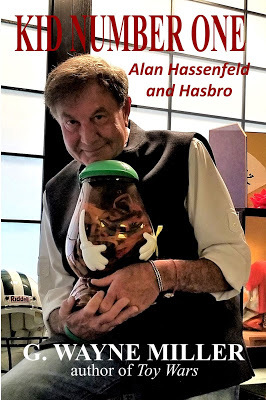
Early praise for KID NUMBER ONE: “G. Wayne Miller reports like a demon and writes like an angel, and Kid Number One is a masterful example of his craft. In Miller’s hands, the story of Alan Hassenfeld’s quirky and ultimately selfless life adventure is an inspiration and a delight. It’s a special treat for readers who like their hard-edged business reporting leavened by celebrity guest appearances by Mr. Potato Head, G.I. Joe and the odd dollop of Flubber. A triumph!”-- Washington Post senior correspondent Kevin Sullivan and author of the #1 New York Times bestseller “Hope: A Memoir of Survival and Cleveland.”
“Kid Number One is a compulsively readable and beautifully researched tour through one family’s impact on a world that has impacted us all: the toy industry. This is a unique and fascinating book.”-- Daniela Lamas, author of the best-selling “You Can Stop Humming Now: A doctor’s stories of life, death and in between.”
“Combining family and corporate history, Kid Number One reveals the deeply personal family story at the heart of Hasbro's corporate identity. From family business to a cornerstone of American popular culture, G. Wayne Miller's history sheds light on the family and the values at the heart of one the globe's most recognizable brands.”-- Julian C. Chambliss, historian, scholar and author of “Assembling the Marvel Cinematic Universe: Essays on the Social, Cultural and Geopolitical Domains.”
“Extensively researched, engaging collection of stories that follow the fortunes of one immigrant family... This is not, however, an unstinting eulogy - Miller unflinchingly discusses family strife and decisions that nearly proved disastrous to the business, even as he recounts the successes When we meet Alan Hassenfeld, we are shown the gentle humor that infused his life and work…“Yet this is more than a mere historical account of one successful man, family, or company - it is also a set of stories that forces us to examine our current attitudes toward immigration; indeed, in the chapter ‘Reach for the Stars,’ Miller explicitly connects his retelling with the politics of today - and this honest questioning, taken together with his tenderly painted portrait of Alan Hassenfeld, a quiet, hard-working, ambitious and yet socially conscious entrepreneur and philanthropist who embodied the American Dream, will leave a lasting impression on the minds of readers.”-- Padma Venkatraman, bestselling author of “The Bridge Home” and other best-selling books.
“Originally built upon the backbone of two immigrant brothers, take a journey with G. Wayne Miller and learn what truly defines the HASBRO name: Hassenfeld, Ambition, Success, Benevolence, Rhode Island, and Optimism. A must read for anyone who values family, creativity, and making a difference!”-- Dan Klingensmith Jr., G.I. Joe historian and author of G.I. Joe books.
Read an excerpt from “Kid Number One”: www.kidnumberone.com
About the Author:This is G. Wayne Miller’s 17th book. He is also a filmmaker, a podcaster, a Providence Journal staff writer, a visiting fellow at Salve Regina University’s Pell Center for International Relations and Public Policy, and co-host and co-producer of the Telly Award-winning weekly national PBS TV and SiriusXM Satellite Radio show “Story in the Public Square.” Miller was a member of The Providence Journal team that was a finalist for the 2004 Pulitzer Prize for Public Service for the newspaper’s coverage of The Station nightclub fire that killed 100, and he has been honored for his work more than 50 times. His fiction and non-fiction books have won wide critical acclaim and been translated into several languages. Visit Miller at www.gwaynemiller.com
KID NUMBER ONE: A story of heart, soul and business, featuring Alan Hassenfeld and Hasbroby G. Wayne Miller
Hardcover: $35.00
ISBN: 978-1-950339-20-4
Attachments:cover image, author photo
###
Published on August 21, 2019 11:14
August 15, 2019
Sylvia K. Hassenfeld, September 19, 1920, to August 15, 2014
This passage is from Chapter Nine of "Kid Number One: A story of heart, soul and business, featuring Alan Hassenfeld and Hasbro." Eulogist Jehuda Reinharz, former president of Brandeis University, spoke at the funeral of Sylvia, Ala Hassenfeld's mother. The funeral was at Providence’s Temple Beth-El, not far from the home where Sylvia and Merrill raised him and brother Stephen.
*****
Reinharz said he knew about Hassenfeld before meeting her in 1994, when he assumed the presidency of “a university with a lackluster board, among a long list of other problems”—and was told that if he could convince Sylvia, by reputation “a dynamo,” to join the board, many of those problems would begin to be resolved.
So taking a deep breath, he telephoned her.
“Come to see me next week at 4 p.m. at my apartment” in Manhattan, she said.
“I was served the customary Sylvia specialty of a small cup of coffee and two cookies,” Reinharz recalled. “And I made my case.”
He had never met any potential donor, Reinharz said, who was “as straightforward as Sylvia. She did not play coy.”
Who was on the board? she asked. Who will survive and who will be sacrificed? What would my role be?
“She was not going to be a decoration or a symbol of gender diversity,” Reinharz said. “I told her I expected her to make financial contributions and help me build up the rest of the board. Sylvia agreed on the spot with the following brief sentence: ‘I will join the board and I will support you.’ And she was true to her word. So began a most wonderful relationship between one of the most remarkable women of our generation and a grateful new university president.”
Hassenfeld’s many philanthropic passions impressed Reinharz. “Her energy was boundless,” he said. “I was incredulous about the travelling she did.”
Echoes of Alan.
“Yes, she also lived very well,” Reinharz said. “She loved to dress well, eat well, laugh at good jokes, and she could have fun playing bridge with the best of them. On the other hand, she disliked pretentious people who took themselves seriously.”
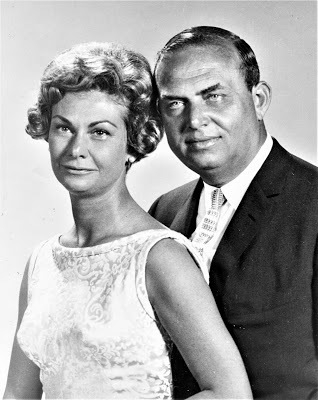 Sylvia and Merrill Hassenfeld, 1961.
Sylvia and Merrill Hassenfeld, 1961.
Reinharz drew knowing laughter in his descriptions of Hassenfeld’s mannerisms and style. “Despite her endless travel schedule,” he said, “Sylvia never missed a board or committee meeting. She sat at the meetings like a queen, never wearing the same outfit twice. She had read all the materials sent to her beforehand, was well informed, and had a no-nonsense attitude.”
He related how Hassenfeld and fellow board member Ann Richards, former governor of Texas, formed a powerful duo in accomplishing his agenda. Before meetings, he said, “I would tell them exactly what I wanted, and they would literally intimidate the board into passing my agenda. Sylvia simply said, ‘Here is what I think. And here’s what needs to be done.’ And Ann Richards would chime in and say immediately afterwards, ‘I totally agree, let’s vote.’ And that was it… No one on the board wanted to cross these two women.”
Laughter filled the temple.
In closing, Reinharz put humor aside for respectful tribute.
“Obviously, Sylvia was a woman of great wealth, who, like many of her generation, could have spent her life in leisure activities, writing the occasional large check and feeling good about it,” he said. “But Sylvia chose a different path. She did not just write checks. She did the work. She got involved in every aspect of the organizations she worked for; talked to everyone, rich and poor; prime ministers as well as the most powerless and vulnerable people in our society. She traveled tirelessly throughout the world trying to improve the lives of less fortunate individuals and communities.”
He could have been describing her son.
“She teaches us that with privilege come obligations and opportunities,” Reinharz said. “Not many people can say that they have changed the world for the better. I believe Sylvia is one of those who truly has. We will all miss her very much. May her memory be a blessing.”
*****
Reinharz said he knew about Hassenfeld before meeting her in 1994, when he assumed the presidency of “a university with a lackluster board, among a long list of other problems”—and was told that if he could convince Sylvia, by reputation “a dynamo,” to join the board, many of those problems would begin to be resolved.
So taking a deep breath, he telephoned her.
“Come to see me next week at 4 p.m. at my apartment” in Manhattan, she said.
“I was served the customary Sylvia specialty of a small cup of coffee and two cookies,” Reinharz recalled. “And I made my case.”
He had never met any potential donor, Reinharz said, who was “as straightforward as Sylvia. She did not play coy.”
Who was on the board? she asked. Who will survive and who will be sacrificed? What would my role be?
“She was not going to be a decoration or a symbol of gender diversity,” Reinharz said. “I told her I expected her to make financial contributions and help me build up the rest of the board. Sylvia agreed on the spot with the following brief sentence: ‘I will join the board and I will support you.’ And she was true to her word. So began a most wonderful relationship between one of the most remarkable women of our generation and a grateful new university president.”
Hassenfeld’s many philanthropic passions impressed Reinharz. “Her energy was boundless,” he said. “I was incredulous about the travelling she did.”
Echoes of Alan.
“Yes, she also lived very well,” Reinharz said. “She loved to dress well, eat well, laugh at good jokes, and she could have fun playing bridge with the best of them. On the other hand, she disliked pretentious people who took themselves seriously.”
 Sylvia and Merrill Hassenfeld, 1961.
Sylvia and Merrill Hassenfeld, 1961.Reinharz drew knowing laughter in his descriptions of Hassenfeld’s mannerisms and style. “Despite her endless travel schedule,” he said, “Sylvia never missed a board or committee meeting. She sat at the meetings like a queen, never wearing the same outfit twice. She had read all the materials sent to her beforehand, was well informed, and had a no-nonsense attitude.”
He related how Hassenfeld and fellow board member Ann Richards, former governor of Texas, formed a powerful duo in accomplishing his agenda. Before meetings, he said, “I would tell them exactly what I wanted, and they would literally intimidate the board into passing my agenda. Sylvia simply said, ‘Here is what I think. And here’s what needs to be done.’ And Ann Richards would chime in and say immediately afterwards, ‘I totally agree, let’s vote.’ And that was it… No one on the board wanted to cross these two women.”
Laughter filled the temple.
In closing, Reinharz put humor aside for respectful tribute.
“Obviously, Sylvia was a woman of great wealth, who, like many of her generation, could have spent her life in leisure activities, writing the occasional large check and feeling good about it,” he said. “But Sylvia chose a different path. She did not just write checks. She did the work. She got involved in every aspect of the organizations she worked for; talked to everyone, rich and poor; prime ministers as well as the most powerless and vulnerable people in our society. She traveled tirelessly throughout the world trying to improve the lives of less fortunate individuals and communities.”
He could have been describing her son.
“She teaches us that with privilege come obligations and opportunities,” Reinharz said. “Not many people can say that they have changed the world for the better. I believe Sylvia is one of those who truly has. We will all miss her very much. May her memory be a blessing.”
Published on August 15, 2019 03:00
June 30, 2019
Kid Number One to be published in September!
Kid Number One: A story of heart, soul and business, featuring Alan Hassenfeld and Hasbro is
a compelling narrative through a culturally and socially relevant world that is rarely seen -- a world that will interest all, whether you are into history, biography, politics or the high-stakes businesses of toys, games, entertainment and Hollywood.
My 17th published book, Kid Number One is both prequel and sequel to my Toy Wars: The epic struggle between G.I. Joe, Barbie and the companies that make them, the bestselling and critically acclaimed tour-de-force of the toy and entertainment universe.
Visit the Kid Number One website to learn more, and follow us on Twitter and Facebook.
#KidNumberOne
Summary
Having escaped religious persecution in Eastern Europe in 1903, Alan Hassenfeld’s grandfather and great-uncle arrived in America as penniless teenage immigrants – refugees who went from hawking rags on the streets of New York City to building what became the world’s largest toy company, Hasbro. Alan’s father, Merrill, brought Mr. Potato Head and G.I. Joe to consumers and his only brother, Stephen, made Hasbro a Fortune 500 company and Hollywood player. Alan was the free spirit who wanted to write novels, date beautiful women and travel the world. He never wanted to run Hasbro, and no one ever believed he would – or could.
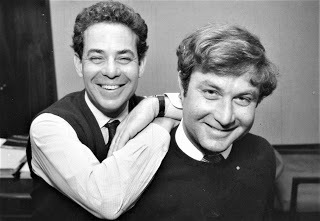 Stephen and Alan Hassenfeld, in happy times.
Stephen and Alan Hassenfeld, in happy times.
And then Stephen died, tragically of AIDS. “Kid Number One,” as Alan liked to call himself, was suddenly chairman and CEO. Silencing the skeptics, he took the company to greater heights – and then almost killed it with a series of bad decisions including Hasbro’s acquisition of rights to POKéMON. Putting ego aside, Hassenfeld gave his long-time lieutenant Al Verrecchia command and set in motion a plan whereby he would leave the corner office. Verrecchia saved the company, and after renewed success, he himself retired, leaving Hasbro in the hands of current CEO and chairman Brian Goldner, so highly regarded that he was brought onto the board of CBS.
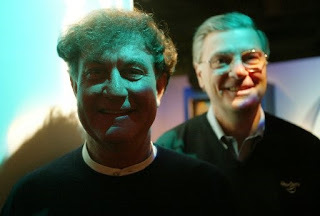 Alan Hassenfeld and Al Verrecchia, running Hasbro.
Alan Hassenfeld and Al Verrecchia, running Hasbro.
With his fortune, Hassenfeld could have sailed into the sunset on a yacht, but instead, he went to work expanding the long family tradition of Tikkun Olam – “repairing the world” – begun by his grandfather and great-uncle, who, grateful to have survived, tirelessly helped immigrants and needy citizens of their new country. Alan Hassenfeld’s philanthropy has helped build two children’s hospitals, establish numerous educational and health programs, train young doctors and scientists, resettle refugees, promote peace in the Mideast and more. For decades, he also has been a highly visible advocate for national political and ethics reform, despite personal threats and the scorn of crooked politicians.
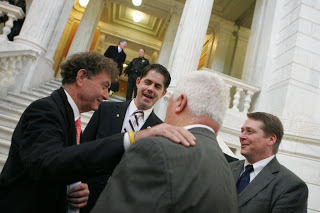 Alan Hassenfeld at the Rhode Island State House.
Alan Hassenfeld at the Rhode Island State House.
Kid Number One: A story of heart, soul and business, featuring Alan Hassenfeld and Hasbro, weaves these stories into a seamless, dramatic narrative that begins with the slaughter of Jews in 1903 Poland and continues to today -- when in an era of unchecked narcissism and greed, Hassenfeld, like Bill Gates, serves as a model for what people of great wealth can do when they put self aside. Kid Number One also chronicles the history of American toys -- and not just such Hasbro classics as Monopoly, Transformers and Star Wars, but also Mattel’s timeless brands including Barbie and many lesser-known toys by companies large and small, many no longer in existence.
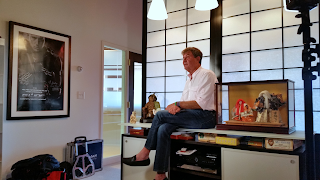 Hassenfeld in his family foundation headquarters.
Hassenfeld in his family foundation headquarters.Both prequel and sequel to Miller’s Toy Wars: The epic struggle between G.I. Joe, Barbie and the companies that make them, the bestselling and critically acclaimed book, Kid Number One is a compelling narrative that will interest all.
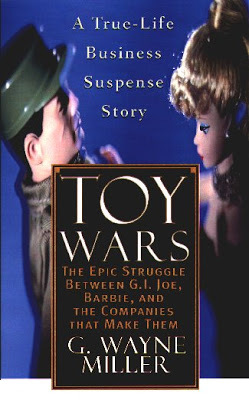

Published on June 30, 2019 12:47
June 29, 2019
Fr. Jared Costanza's homily at Jim Taricani's funeral, June 27, 2019
Fr. Jared Costanza celebrated Jim's funeral Mass at Christ the King Church in Kingston and delivered an extraordinary homily that was part of an extraordinary farewell to the wonderful person and journalist, Jim Taricani. The Mass was rich with remembrance, praise, music (the Beatles, no less!) and humor that Jim would so have appreciated in Father Costanza's words and remarks by federal judge William Smith.
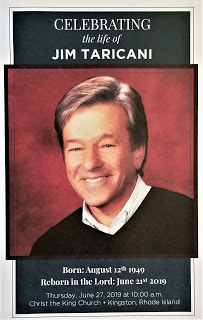
Here is the text of Father Costanza's homily:
Late Friday night, a knock was heard at heaven's door.
St. Peter called out, "Who is it?" The answer came: “It’s Jim Taricani." Just then, every cardinal, priests and bishop up there yelled: “Everybody run! Hide! Don’t open that door!”
Of course, we know the Lord well enough to realize that his door is never locked – it always opens when we knock.Our God is a Father who sits and waits by that door, watching for us, keeping vigil, until we all make it home safely – especially after a journey like the one Jim took: long. Winding. Rocky. Steep. Tough.But tough roads and tough journeys make for tough people, and that’s why so many people admired Jim:he stayed the course in the face of adversity – he was tough; he was a fighter.And for that reason, you always wanted him on your side … and that’s exactly where Rhode Islanders found him: on their side... in their corner, giving meaning to the phrase “the pen is mightier than the sword.”Jim had no fear. He wasn’t afraid of the mob, he wasn’t afraid of the feds, he wasn’t afraid of judges or prisons;he wasn’t afraid of the sacrifices – he wasn’t even afraid of dying. He carried his crosses with courage – always with courage.Professionally, fear would have cost Jim his reputation; personally, it would’ve cost him his life.So for Jim, fear wasn’t even an option – there was too much at stake; too many precious things would be lost, especially the trust that he built up.
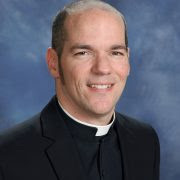 Father CostanzaMore than telling stories and breaking news, Jim used his passion to build trust –his work and dedication allowed him to build relationships with the community, and it was a SACRED trust – what a privilege that was for Jim – such an incredible opportunity ... but such a great responsibility – a responsibility that Jim took so professionally, so seriously.He knew his audience, and he trusted his audience.We can think back to Jesus, who used parables to teach – Jesus trusted his audience to look deeper, beyond the surface meaning of those stories, right?Journalists inspire their audiences to look deeper into social issues and to grow; change; reform; to become better, greater – more aware, more unified, and thus better equipped to work out our problems and respond to the opportunities we get to make a difference, contribute to the community, and advance the common good.
Father CostanzaMore than telling stories and breaking news, Jim used his passion to build trust –his work and dedication allowed him to build relationships with the community, and it was a SACRED trust – what a privilege that was for Jim – such an incredible opportunity ... but such a great responsibility – a responsibility that Jim took so professionally, so seriously.He knew his audience, and he trusted his audience.We can think back to Jesus, who used parables to teach – Jesus trusted his audience to look deeper, beyond the surface meaning of those stories, right?Journalists inspire their audiences to look deeper into social issues and to grow; change; reform; to become better, greater – more aware, more unified, and thus better equipped to work out our problems and respond to the opportunities we get to make a difference, contribute to the community, and advance the common good.
Jim’s many gifts, blessings, and talents, for which we give thanks at this Mass, were not used selfishly;Jim used them in service to others – so many others, who looked up to him as a guide, a teacher, a mentor, a big brother, an advocate – because he challenged people to become more;he inspired them to discover their own blessings and strengths, and to engage them in order to reach their potential to be great.Jim believed that journalism is a service industry: it’s a service to the community; it’s a service to the truth,And, when it’s considered a privilege and used responsibly, it has the power to bring about change for the better –change to help common folks and the common good,by uncovering the truth, which is so often beneath the surface, beyond the boundaries, and behind barriers, but wherever it was, Jim wouldn’t quit until he found it, and his passion helped to form public opinion.
Of course, Jim had some opinions of his own, and he wasn’t afraid to let you know about them.Scan his Twitter page, and you will come across gems like these:(*) “The way many Rhode Islanders rush to get milk and bread at mention of a snowstorm is THE most ridiculous thing I've seen in my 44 years in RI.” (*) “Why ANYONE would believe ANYTHING in ANY campaign ad is beyond me.” (*) Commenting on a story about how Rhode Island is ranked #1 in structurally deficient bridges, Jim said: "At least we're #1 in something!" (*) And my favorite of Jim’s observations:“The state should have let mob bookies run the [sports] gambling... they know how to make it profitable.”Surely, the many crosses that Jim carried through this world were made lighter by his sense of humor!
Then, on a more serious note, on August 22, last year, the 22nd anniversary of Jim's heart transplant, Jim said: "Thank God for my organ donor." Jim was very humbled and thankful that his life was saved and very much extended – far beyond the time that he was told that he would have – and that overwhelmed him; it humbled him.It began with a young man named Alvaro (AL-vah-ro) Leveron, whose parents allowed his heart to be harvested and given to Jim.Because of that spirit of thoughtfulness, selflessness, and generosity,the tragedy that took Alvaro’s life was not the end of him – it wasn’t the end of his story.Instead, his spirit would live on, his story could be told and retold in the new lease on life that Jim received.And Jim wanted to honor Alvaro by being honorable and living honorably because he felt so greatly blessed.
It reminds me of the story of a boywho was swimming at the beach, got caught up in the riptide and began to drown.After his friends hadn’t seen him surface, they became to scream and shout for the lifeguard.The lifeguard jumped from his chair, ran across the beach, and swam as fast as he could to reach the child.He found him, carried him back to shore, and performed CPR until the boy was revived.After the child came to, he caught his breath, and wiped his tears away, and finally looked up at the lifeguard and said, “Mister, how can I repay you, you saved my life!”The lifeguard said, “It’s okay kid. Just make sure your life was worth saving.”Jim made sure his life was worthy of being saved – worthy of another’s sacrifice and goodness.What honor Jim brought to his donor by living an honorable life.Today, we give thanks to the God who has given us a heart to live and to love; to forgive and let live.We remember that our heavenly Father is the divine donor who gives us a mind to think; a body to act…passions to inspire us; He gave us a mouth to speak and pass on blessings and encouragement to others;He gave us eyes to see, to notice the needs of others; ears to hear the cry of the poor and marginalized;He gave us a conscience to follow.What honor we bring to our Creator when we use those gifts He has given to us for the benefit of others.
Jim’s priorities often centered around others.And Jim was always able to recognize the goodness in people – he could spot a con artist, for sure – he once referred to his “con artist antennas,” like radar I guess for con artists… and… artists of a… similar kind, we might say.But more importantly, he could also spot the goodness in people; in the community; in you.Even when, sometimes, you couldn’t see it in yourself, Jim could see it and bring out the best in you.And all that goodness he saw inspired him to hold out hope – even in the darkness, brokenness, and confusion of our world, there’s always light.There needs to be more, and Jim did his part to shine the sunlight where it needed to go, in more ways than one.Ask him how he was feeling, even on his most difficult days, and he’d say: “Good!” “Great!”
That’s how grateful he was to be living:his experience gave him a fierce determination to live and to make the best out of life, and to enjoy life.And when life is good, you have no room or time to complain about your struggles, and he didn’t.There’s no use cursing the darkness when you can light a lamp and be light for others in the darkness.
As a light himself, Jim was certainly very grateful for the many honors, award, and recognitions he received for his work,but he was more interested in honoring the work of others:congratulating you for your accomplishments, stories, awards, and hard work in those news rooms – “Great scoop!” he’d say… “Great insight!” “Great instincts!” – And if you were a journalist? And you heard that from Jim?That meant everything to you; it inspired you, because you knew Jim was legit – you don’t become a legend like Jim without having experienced what it takes – the risks, the hours, the sacrifices, the commitment, the patience …staying the course even when others doubt you or discourage you.Jim acknowledged and appreciated this when he saw it in others; he was so quick and generous to offer praise to those whose work was truly solid and inspiring and changed things for the better:especially teachers, veterans, nurses, firefighters and EMTs…He praised organ donors, ALL of you… journalists, MOST of you... politicians, SOME of you… and clergy … okay, NONE of us! But he was fair, he was honest…Nothing was personal, but no one was above the fray or beyond reproach,and this is why he’s being remembered the way he is, and why we respected him: he had a job to do, people to serve, and a truth to uncover,and he would stop at nothing to serve that truth – he would have given his life for free speech and a free press,and if he had, he would have joined some 34 journalists who were murdered throughout the world in 2018.Another 60 were killed on the job, having put their lives in danger covering violence, corruption, and war.More than 250 are sitting in jails today, just for doing their duty.People have the right to the truth; and it’s a journalist’s obligation to find and report it.We take that for granted – even here at home, where we see them belittled, demeaned, dismissed and targeted by those whose power is threatened by honesty and transparency.“Keep digging!” Jim would say, “Keep digging!” and the legal protections will come, freedom will prevail, truth will prevail, and your work will continue to bear fruit for the world; it will speak for itself.
We’ll be amazed by what we find when we “keep digging” through life, as Jim did.We will find the strength to overcome obstacles.We will find a deep appreciation for the people in our lives and the freedoms we enjoy.We will discover and rediscover our meaning and purpose in this world,and learn to be satisfied and at peace with who we are, what we have, and where we’re going.We will experience the support of so many good people in the community we share.We will learn to appreciate the value of life and the time we have left in this world.We don’t know how long we’ll have, so we’ve gotta make it count, and embrace every day, every opportunity, with Jim’s attitude and courageous spirit – a spirit too powerful, too pure to be bound inside of a box or a grave.
Open the door, Lord God, and let the spirit of your servant Jim abide with you, and rest in you,for you are the way, the truth, and the life.Amen.
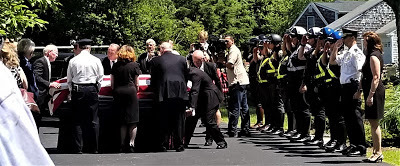
Afterward, some of Jim's friends, Providence Journal staffers past and present, members of a many-media honor guard, gathered to chat. If I may (with a single, over-used word) describe everyone's reaction to the service it would be: Wow. Thanks, Jim, for all you did for so many.
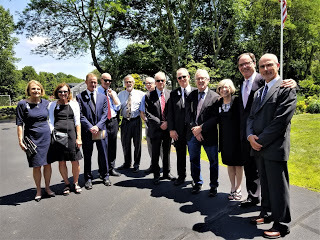
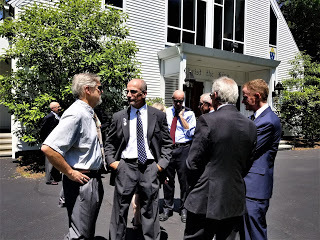

Here is the text of Father Costanza's homily:
Late Friday night, a knock was heard at heaven's door.
St. Peter called out, "Who is it?" The answer came: “It’s Jim Taricani." Just then, every cardinal, priests and bishop up there yelled: “Everybody run! Hide! Don’t open that door!”
Of course, we know the Lord well enough to realize that his door is never locked – it always opens when we knock.Our God is a Father who sits and waits by that door, watching for us, keeping vigil, until we all make it home safely – especially after a journey like the one Jim took: long. Winding. Rocky. Steep. Tough.But tough roads and tough journeys make for tough people, and that’s why so many people admired Jim:he stayed the course in the face of adversity – he was tough; he was a fighter.And for that reason, you always wanted him on your side … and that’s exactly where Rhode Islanders found him: on their side... in their corner, giving meaning to the phrase “the pen is mightier than the sword.”Jim had no fear. He wasn’t afraid of the mob, he wasn’t afraid of the feds, he wasn’t afraid of judges or prisons;he wasn’t afraid of the sacrifices – he wasn’t even afraid of dying. He carried his crosses with courage – always with courage.Professionally, fear would have cost Jim his reputation; personally, it would’ve cost him his life.So for Jim, fear wasn’t even an option – there was too much at stake; too many precious things would be lost, especially the trust that he built up.
 Father CostanzaMore than telling stories and breaking news, Jim used his passion to build trust –his work and dedication allowed him to build relationships with the community, and it was a SACRED trust – what a privilege that was for Jim – such an incredible opportunity ... but such a great responsibility – a responsibility that Jim took so professionally, so seriously.He knew his audience, and he trusted his audience.We can think back to Jesus, who used parables to teach – Jesus trusted his audience to look deeper, beyond the surface meaning of those stories, right?Journalists inspire their audiences to look deeper into social issues and to grow; change; reform; to become better, greater – more aware, more unified, and thus better equipped to work out our problems and respond to the opportunities we get to make a difference, contribute to the community, and advance the common good.
Father CostanzaMore than telling stories and breaking news, Jim used his passion to build trust –his work and dedication allowed him to build relationships with the community, and it was a SACRED trust – what a privilege that was for Jim – such an incredible opportunity ... but such a great responsibility – a responsibility that Jim took so professionally, so seriously.He knew his audience, and he trusted his audience.We can think back to Jesus, who used parables to teach – Jesus trusted his audience to look deeper, beyond the surface meaning of those stories, right?Journalists inspire their audiences to look deeper into social issues and to grow; change; reform; to become better, greater – more aware, more unified, and thus better equipped to work out our problems and respond to the opportunities we get to make a difference, contribute to the community, and advance the common good.Jim’s many gifts, blessings, and talents, for which we give thanks at this Mass, were not used selfishly;Jim used them in service to others – so many others, who looked up to him as a guide, a teacher, a mentor, a big brother, an advocate – because he challenged people to become more;he inspired them to discover their own blessings and strengths, and to engage them in order to reach their potential to be great.Jim believed that journalism is a service industry: it’s a service to the community; it’s a service to the truth,And, when it’s considered a privilege and used responsibly, it has the power to bring about change for the better –change to help common folks and the common good,by uncovering the truth, which is so often beneath the surface, beyond the boundaries, and behind barriers, but wherever it was, Jim wouldn’t quit until he found it, and his passion helped to form public opinion.
Of course, Jim had some opinions of his own, and he wasn’t afraid to let you know about them.Scan his Twitter page, and you will come across gems like these:(*) “The way many Rhode Islanders rush to get milk and bread at mention of a snowstorm is THE most ridiculous thing I've seen in my 44 years in RI.” (*) “Why ANYONE would believe ANYTHING in ANY campaign ad is beyond me.” (*) Commenting on a story about how Rhode Island is ranked #1 in structurally deficient bridges, Jim said: "At least we're #1 in something!" (*) And my favorite of Jim’s observations:“The state should have let mob bookies run the [sports] gambling... they know how to make it profitable.”Surely, the many crosses that Jim carried through this world were made lighter by his sense of humor!
Then, on a more serious note, on August 22, last year, the 22nd anniversary of Jim's heart transplant, Jim said: "Thank God for my organ donor." Jim was very humbled and thankful that his life was saved and very much extended – far beyond the time that he was told that he would have – and that overwhelmed him; it humbled him.It began with a young man named Alvaro (AL-vah-ro) Leveron, whose parents allowed his heart to be harvested and given to Jim.Because of that spirit of thoughtfulness, selflessness, and generosity,the tragedy that took Alvaro’s life was not the end of him – it wasn’t the end of his story.Instead, his spirit would live on, his story could be told and retold in the new lease on life that Jim received.And Jim wanted to honor Alvaro by being honorable and living honorably because he felt so greatly blessed.
It reminds me of the story of a boywho was swimming at the beach, got caught up in the riptide and began to drown.After his friends hadn’t seen him surface, they became to scream and shout for the lifeguard.The lifeguard jumped from his chair, ran across the beach, and swam as fast as he could to reach the child.He found him, carried him back to shore, and performed CPR until the boy was revived.After the child came to, he caught his breath, and wiped his tears away, and finally looked up at the lifeguard and said, “Mister, how can I repay you, you saved my life!”The lifeguard said, “It’s okay kid. Just make sure your life was worth saving.”Jim made sure his life was worthy of being saved – worthy of another’s sacrifice and goodness.What honor Jim brought to his donor by living an honorable life.Today, we give thanks to the God who has given us a heart to live and to love; to forgive and let live.We remember that our heavenly Father is the divine donor who gives us a mind to think; a body to act…passions to inspire us; He gave us a mouth to speak and pass on blessings and encouragement to others;He gave us eyes to see, to notice the needs of others; ears to hear the cry of the poor and marginalized;He gave us a conscience to follow.What honor we bring to our Creator when we use those gifts He has given to us for the benefit of others.
Jim’s priorities often centered around others.And Jim was always able to recognize the goodness in people – he could spot a con artist, for sure – he once referred to his “con artist antennas,” like radar I guess for con artists… and… artists of a… similar kind, we might say.But more importantly, he could also spot the goodness in people; in the community; in you.Even when, sometimes, you couldn’t see it in yourself, Jim could see it and bring out the best in you.And all that goodness he saw inspired him to hold out hope – even in the darkness, brokenness, and confusion of our world, there’s always light.There needs to be more, and Jim did his part to shine the sunlight where it needed to go, in more ways than one.Ask him how he was feeling, even on his most difficult days, and he’d say: “Good!” “Great!”
That’s how grateful he was to be living:his experience gave him a fierce determination to live and to make the best out of life, and to enjoy life.And when life is good, you have no room or time to complain about your struggles, and he didn’t.There’s no use cursing the darkness when you can light a lamp and be light for others in the darkness.
As a light himself, Jim was certainly very grateful for the many honors, award, and recognitions he received for his work,but he was more interested in honoring the work of others:congratulating you for your accomplishments, stories, awards, and hard work in those news rooms – “Great scoop!” he’d say… “Great insight!” “Great instincts!” – And if you were a journalist? And you heard that from Jim?That meant everything to you; it inspired you, because you knew Jim was legit – you don’t become a legend like Jim without having experienced what it takes – the risks, the hours, the sacrifices, the commitment, the patience …staying the course even when others doubt you or discourage you.Jim acknowledged and appreciated this when he saw it in others; he was so quick and generous to offer praise to those whose work was truly solid and inspiring and changed things for the better:especially teachers, veterans, nurses, firefighters and EMTs…He praised organ donors, ALL of you… journalists, MOST of you... politicians, SOME of you… and clergy … okay, NONE of us! But he was fair, he was honest…Nothing was personal, but no one was above the fray or beyond reproach,and this is why he’s being remembered the way he is, and why we respected him: he had a job to do, people to serve, and a truth to uncover,and he would stop at nothing to serve that truth – he would have given his life for free speech and a free press,and if he had, he would have joined some 34 journalists who were murdered throughout the world in 2018.Another 60 were killed on the job, having put their lives in danger covering violence, corruption, and war.More than 250 are sitting in jails today, just for doing their duty.People have the right to the truth; and it’s a journalist’s obligation to find and report it.We take that for granted – even here at home, where we see them belittled, demeaned, dismissed and targeted by those whose power is threatened by honesty and transparency.“Keep digging!” Jim would say, “Keep digging!” and the legal protections will come, freedom will prevail, truth will prevail, and your work will continue to bear fruit for the world; it will speak for itself.
We’ll be amazed by what we find when we “keep digging” through life, as Jim did.We will find the strength to overcome obstacles.We will find a deep appreciation for the people in our lives and the freedoms we enjoy.We will discover and rediscover our meaning and purpose in this world,and learn to be satisfied and at peace with who we are, what we have, and where we’re going.We will experience the support of so many good people in the community we share.We will learn to appreciate the value of life and the time we have left in this world.We don’t know how long we’ll have, so we’ve gotta make it count, and embrace every day, every opportunity, with Jim’s attitude and courageous spirit – a spirit too powerful, too pure to be bound inside of a box or a grave.
Open the door, Lord God, and let the spirit of your servant Jim abide with you, and rest in you,for you are the way, the truth, and the life.Amen.

Afterward, some of Jim's friends, Providence Journal staffers past and present, members of a many-media honor guard, gathered to chat. If I may (with a single, over-used word) describe everyone's reaction to the service it would be: Wow. Thanks, Jim, for all you did for so many.


Published on June 29, 2019 05:12
June 21, 2019
History Starts Here award from the Newport Historical Society
On June 20, 2019, Story in the Public Square co-host and co-producer Jim Lude and I were honored to receive the inaugural History Starts Here award in historic Colony House in Newport, R.I. The award from the Newport Historical Society "will be offered annually to an individual or organization who is making history now or making opportunities for thinking about how history is important to today," according to the society.
We were selected on a vote of the center staff! Folks, it does not get any better than this.
These were my remarks on accepting from society executive director Ruth S. Taylor and Paul McGreevy, president of the board of directors. Jim also spoke.
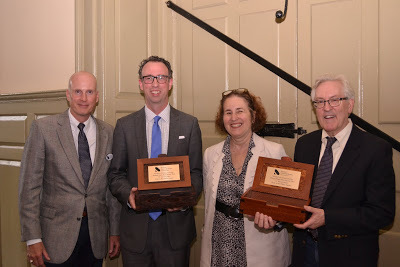 Paul, Jim, Ruth and me.
Paul, Jim, Ruth and me.
Thank you, Ruth. Thank you, Paul. And thank you Newport Historical Society for this amazing honor. Jim Ludes and I were surprised – maybe “shocked” is a better word – when we learned we would be receiving it. And so, with humility, we accept.
My first connection to the Historical Society was in 1983, when I was assigned to The Providence Journal’s old Newport bureau, over there on Thames Street. We were writing stories about the 20th anniversary of the assassination of John F. Kennedy and your archives were an invaluable resource to me. That time was but the first of many hours I have since passed researching stories and books at NHS. What a treasure you are.
This being a celebration of history, let me relate a bit of Story in the Public Square’s own.
Seven years ago this February, in a shop that was literally just around the corner here, I joined Jim for a conversation over coffee. We had met the previous October, when the Pell Center hosted the launch party for my biography of Claiborne Pell, “An Uncommon Man.”
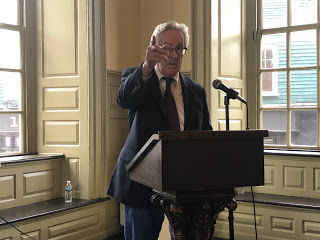
On that winter day – February 23, 2012, to be precise -- Jim discussed his ideas for making the Pell Center the robust place it has become. I, in turn, discussed my desire to extend my storytelling into the academic world.
And so, Story in the Public Square was born. How strange – or maybe not – that our own history began a stone’s throw from Colony House and the Newport Historical Society.
Within a few months, Jim and I had formed a partnership between the Pell Center and The Providence Journal. I was named a visiting fellow and director of Story in the Public Square, and with Teresa Haas, Mia Lupo, and some Salve students, we got to work.
A year later, we staged our first major event: a day-long conference during which we awarded Pulitzer Prize-winning journalist Dana Priest the inaugural Pell Center Prize for Story in the Public Square. The next year, 2014, we staged our second Story conference, with Emmy-winning actor, screenwriter, producer and hit show Empire creator Danny Strong, recipient of the second annual Pell Prize.
And in June 2015, Lisa Genova, best-selling author of “Still Alice” and other novels, received the third annual Prize. Jim and I had the bright idea that interviewing her would make for a good TV show, and so we built a set at the Pell Center and rolled the cameras.
The production qualities were, in a word, terrible.
Mercifully, the world will never see that tape.
But sometime later, Jim had another idea – and this one actually was bright. Why not record at a real TV studio – namely, Rhode Island PBS? So we did, producing eight monthly episodes broadcast in 2016 as part of the show White House Chronicle. Llewellyn and Linda are here today and thank you.
And then, one more idea: Why not our own weekly program?
Rhode Island PBS was enthusiastic, so we had a set designed and built, and in January 2017 we taped our first two shows: Naval War College professor and author Tom Nichols, and Loren Spears, director of the Tomaquag Museum, Rhode Island’s Native American history and culture center, and Christian Hopkins, a Standing Rock activist.
It was game on. Jim and I sometimes say we did not have a clue what we were doing – and to an extent still don’t! -- but the awesome crew at RI PBS does. Thanks to them and an incredible roster of guests – more than 120 storytellers to date, from the worlds of books, film, academia, journalism, still photography, politics, art and more – we were able to go national in September 2018. Today, the program is carried in 43 of the top 50 markets in America, with more than 450 total broadcasts weekly – plus weekly audio on SiriusXM Radio.
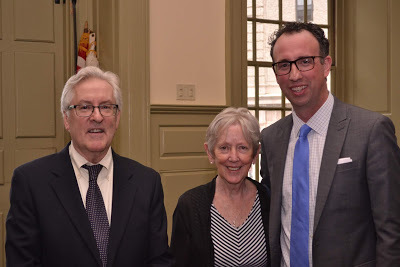 With Salve Regina University Sr. Jane Gerety, a supporter from day one!Over the last few weeks, we have been busy recording our National Season Three, which kicks off July 8 with Lisa Genova, who, despite the debacle of 2015, graciously agreed to return. Following Lisa will be Pulitzer-Prize winning editorial cartoonist Adam Zyglis, the brilliant poet Maggie Smith, and Danny Strong. And many more through the end of the year.
With Salve Regina University Sr. Jane Gerety, a supporter from day one!Over the last few weeks, we have been busy recording our National Season Three, which kicks off July 8 with Lisa Genova, who, despite the debacle of 2015, graciously agreed to return. Following Lisa will be Pulitzer-Prize winning editorial cartoonist Adam Zyglis, the brilliant poet Maggie Smith, and Danny Strong. And many more through the end of the year.
In closing, let me again thank the Newport Historical Society – and the Rhode Island PBS crew, our many great guests, Salve Regina University, and The Providence Journal.
And finally, of course, my partner Jim. Who knew where that conversation seven years ago would lead?
We didn’t... but history sure can be funny that way, I think you’ll agree.
We were selected on a vote of the center staff! Folks, it does not get any better than this.
These were my remarks on accepting from society executive director Ruth S. Taylor and Paul McGreevy, president of the board of directors. Jim also spoke.
 Paul, Jim, Ruth and me.
Paul, Jim, Ruth and me.Thank you, Ruth. Thank you, Paul. And thank you Newport Historical Society for this amazing honor. Jim Ludes and I were surprised – maybe “shocked” is a better word – when we learned we would be receiving it. And so, with humility, we accept.
My first connection to the Historical Society was in 1983, when I was assigned to The Providence Journal’s old Newport bureau, over there on Thames Street. We were writing stories about the 20th anniversary of the assassination of John F. Kennedy and your archives were an invaluable resource to me. That time was but the first of many hours I have since passed researching stories and books at NHS. What a treasure you are.
This being a celebration of history, let me relate a bit of Story in the Public Square’s own.
Seven years ago this February, in a shop that was literally just around the corner here, I joined Jim for a conversation over coffee. We had met the previous October, when the Pell Center hosted the launch party for my biography of Claiborne Pell, “An Uncommon Man.”

On that winter day – February 23, 2012, to be precise -- Jim discussed his ideas for making the Pell Center the robust place it has become. I, in turn, discussed my desire to extend my storytelling into the academic world.
And so, Story in the Public Square was born. How strange – or maybe not – that our own history began a stone’s throw from Colony House and the Newport Historical Society.
Within a few months, Jim and I had formed a partnership between the Pell Center and The Providence Journal. I was named a visiting fellow and director of Story in the Public Square, and with Teresa Haas, Mia Lupo, and some Salve students, we got to work.
A year later, we staged our first major event: a day-long conference during which we awarded Pulitzer Prize-winning journalist Dana Priest the inaugural Pell Center Prize for Story in the Public Square. The next year, 2014, we staged our second Story conference, with Emmy-winning actor, screenwriter, producer and hit show Empire creator Danny Strong, recipient of the second annual Pell Prize.
And in June 2015, Lisa Genova, best-selling author of “Still Alice” and other novels, received the third annual Prize. Jim and I had the bright idea that interviewing her would make for a good TV show, and so we built a set at the Pell Center and rolled the cameras.
The production qualities were, in a word, terrible.
Mercifully, the world will never see that tape.
But sometime later, Jim had another idea – and this one actually was bright. Why not record at a real TV studio – namely, Rhode Island PBS? So we did, producing eight monthly episodes broadcast in 2016 as part of the show White House Chronicle. Llewellyn and Linda are here today and thank you.
And then, one more idea: Why not our own weekly program?
Rhode Island PBS was enthusiastic, so we had a set designed and built, and in January 2017 we taped our first two shows: Naval War College professor and author Tom Nichols, and Loren Spears, director of the Tomaquag Museum, Rhode Island’s Native American history and culture center, and Christian Hopkins, a Standing Rock activist.
It was game on. Jim and I sometimes say we did not have a clue what we were doing – and to an extent still don’t! -- but the awesome crew at RI PBS does. Thanks to them and an incredible roster of guests – more than 120 storytellers to date, from the worlds of books, film, academia, journalism, still photography, politics, art and more – we were able to go national in September 2018. Today, the program is carried in 43 of the top 50 markets in America, with more than 450 total broadcasts weekly – plus weekly audio on SiriusXM Radio.
 With Salve Regina University Sr. Jane Gerety, a supporter from day one!Over the last few weeks, we have been busy recording our National Season Three, which kicks off July 8 with Lisa Genova, who, despite the debacle of 2015, graciously agreed to return. Following Lisa will be Pulitzer-Prize winning editorial cartoonist Adam Zyglis, the brilliant poet Maggie Smith, and Danny Strong. And many more through the end of the year.
With Salve Regina University Sr. Jane Gerety, a supporter from day one!Over the last few weeks, we have been busy recording our National Season Three, which kicks off July 8 with Lisa Genova, who, despite the debacle of 2015, graciously agreed to return. Following Lisa will be Pulitzer-Prize winning editorial cartoonist Adam Zyglis, the brilliant poet Maggie Smith, and Danny Strong. And many more through the end of the year.In closing, let me again thank the Newport Historical Society – and the Rhode Island PBS crew, our many great guests, Salve Regina University, and The Providence Journal.
And finally, of course, my partner Jim. Who knew where that conversation seven years ago would lead?
We didn’t... but history sure can be funny that way, I think you’ll agree.
Published on June 21, 2019 13:00



